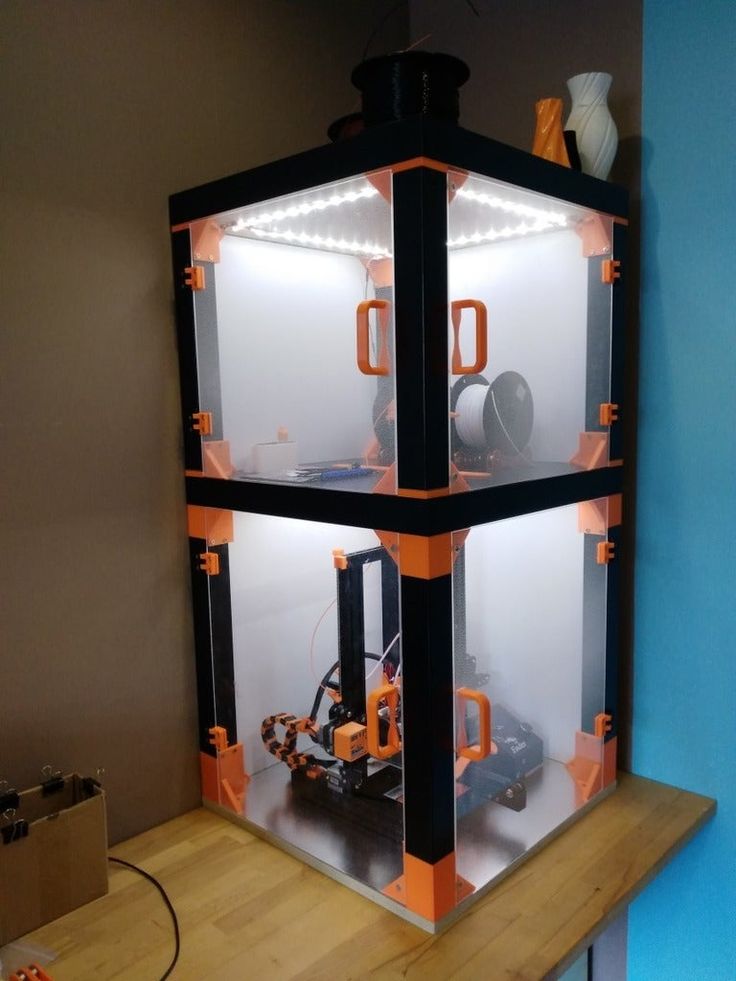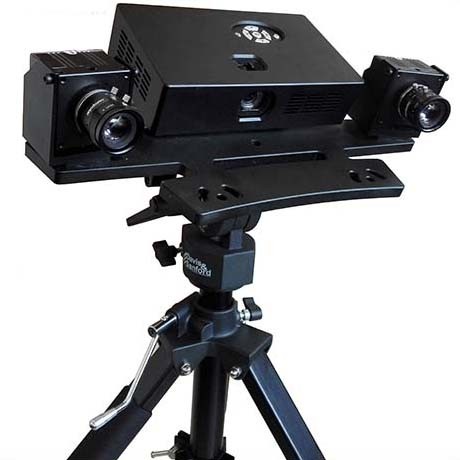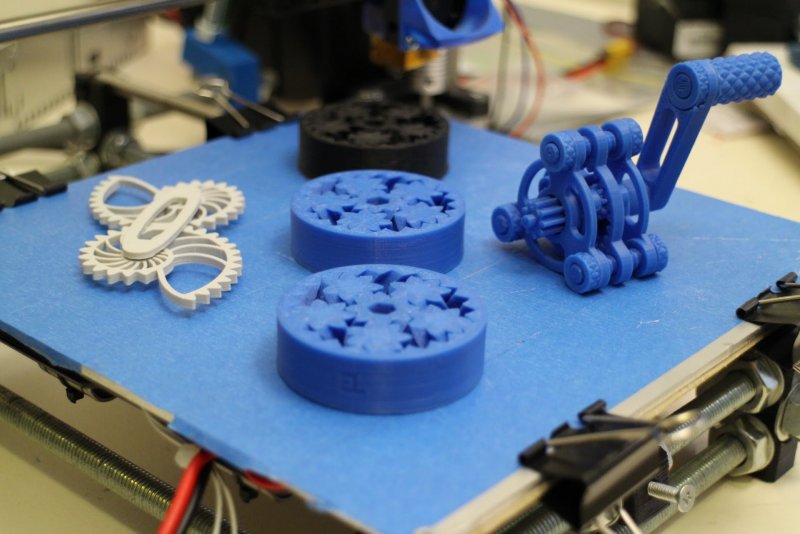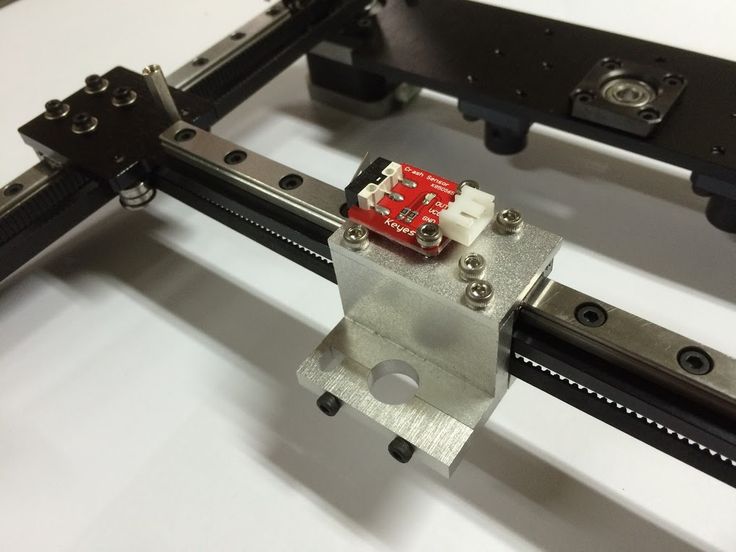Best enclosed 3d printers
7 Best Enclosed 3D Printers In 2023
- Last Updated: January 19, 2023
- Pat Nathaniel
Been on the lookout for an enclosed 3D printer? Whether you want better print quality or to start printing with higher-temperature materials, or if you just want the safety of an enclosure, this guide is for you!
Open-frame 3D printers look cool and can be cheaper than their enclosed counterparts. However, their print beds and hot ends can reach pretty darn high temperatures. And that’s not an ideal situation to mix kids and animals into, or perhaps adults who are not knowledgeable about what parts of a 3D printer you can or can’t touch.
In fact, plenty of 3D printer users have burnt themselves in a moment of not-thinking-before-touching-a-100-degree-surface.
Also, the nasty 3D printing farts (or more professionally, fumes) are not something you want to breathe in an indoor environment.
With our thorough testing and research, we’ve picked out the best enclosed 3D printers available to you today. Let’s get into it!
Monoprice Voxel
Build volume: 150 x 50 x 150 mm
Check Latest Price
Qidi Tech X-Max
Build volume: 300 x 250 x 300 mm
Check Latest Price
Raise3D Pro2
Build volume: 254 x 152 x 170 mm
Check Latest Price
Table of Contents
- Best Enclosed 3D Printers At A Glance
- 1. Qidi Tech X-Max (Best Choice)
- 2. Monoprice Voxel (Best Value)
- 3. Raise3D Pro2 (Premium Choice)
- 4. Dremel DigiLab 3D45-01 (Best Mid-Range 3D Printer)
- 5. Flashforge Adventurer 3 Lite (Best Budget)
- 6. Qidi Tech i-Mate (Most Reliable)
- 7. Dremel DigiLab 3D40-FLX-01 (Best PLA-Specific Printer)
- Advantages and Disadvantages of Enclosed 3D Printers
- Features to Consider:
- Printing Technology
- Build Volume
- Layer Resolution
- Print Speed
- Supported Materials
- Connectivity
- Heated Print Bed
- Extruder Quality
- Dual Extrusion
- Dedicated Slicer or Open Source
- Touch Screen
- Price
- Difference Between Fully and Partially Enclosed 3D Printers
- Is an Enclosed 3D Printer Safe?
- So Which Is the Best Enclosed 3D Printer?
Best Enclosed 3D Printers At A Glance
1.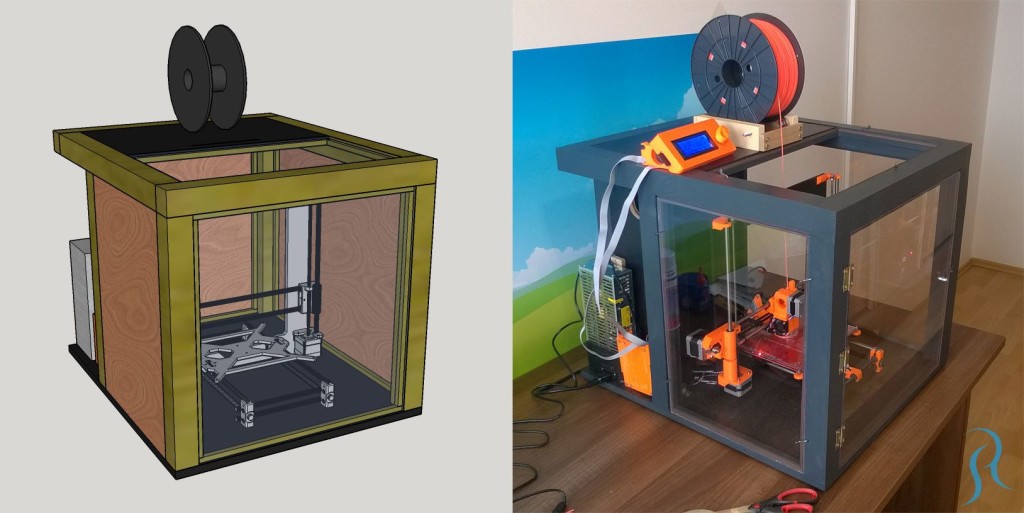 Qidi Tech X-Max (Best Choice)
Qidi Tech X-Max (Best Choice)
2. Monoprice Voxel (Best Value)
3. Raise3D Pro2 (Premium Choice)
4. Dremel DigiLab 3D45-01 (Best Mid-Range 3D Printer)
5. Flashforge Adventurer 3 Lite (Best Budget)
6. Qidi Tech i-Mate (Most Reliable)
7. Dremel DigiLab 3D40-FLX-01 (Best PLA-Specific Printer)
3D Printer Type: FDM | Materials: PLA, ABS, PETG, TPU, Nylon, Carbon Fiber & Polycarbonate | Build Volume: 300 x 250 x 300 mm
We’re not Qidi-ng — the Qidi Tech X-Max is an awesome enclosed 3D printer thanks to its massive build volume, two extruders, and high-temperature build plate.
With a significantly large build volume at 300 x 250 x 300 mm, the X-Max is great for big prints. And it’s got a print quality of up to 100 microns, so you’re gonna get some pretty good quality output with it.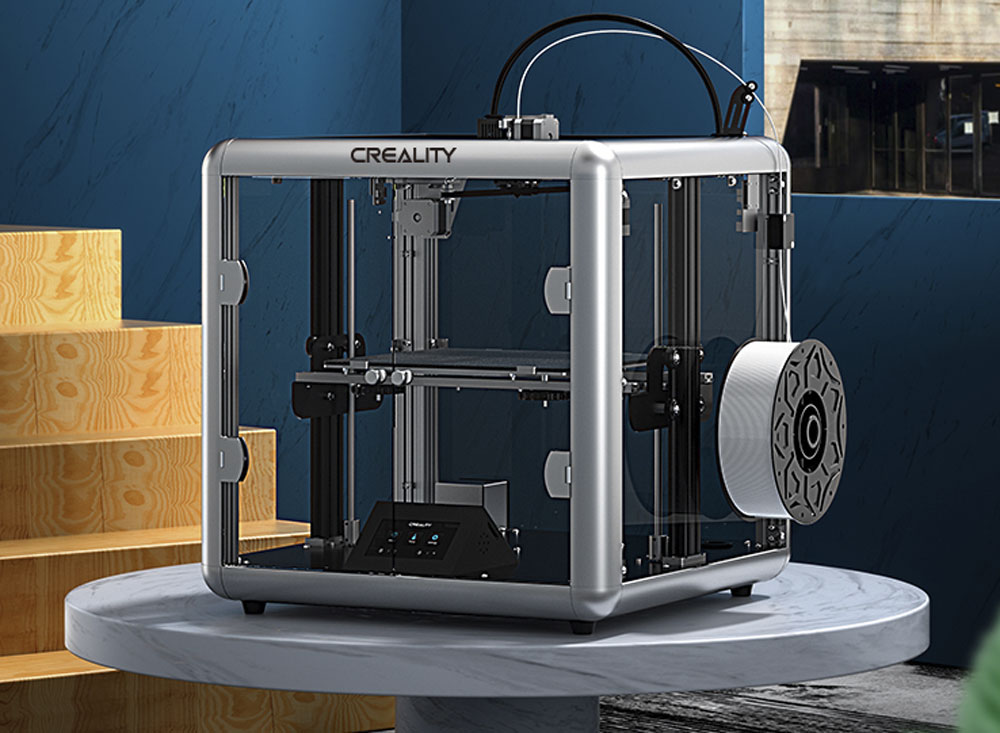
You’ll also find it comes with two extruders — the A extruder is for printing PLA, and the B extruder for printing nylon, TPU, and more uncommon filaments. The presence of two extruders is pretty nifty if you work with different types of filaments.
And another bonus in that field — if you want to work with tricky, higher-temperature filaments, you’re in luck. The Qidi Tech X-Max has a print bed that can heat up to 120 degrees Celsius, making it ideal for printing ABS and other similar filaments.
Its glass enclosure and robust metal frame prevent any wobbling and keep outsiders safe from 3D printing mechanisms. If you can afford it, this is a great enclosed printer that can make bigger prints, as well as successfully print ABS and other higher-temperature filaments.
- Large build volume
- Comes with two different extruders
- Print bed can heat up to 120 degrees Celsius
- Robust metal frame
- Pricier than the budget options on this list
Check Latest Price
2.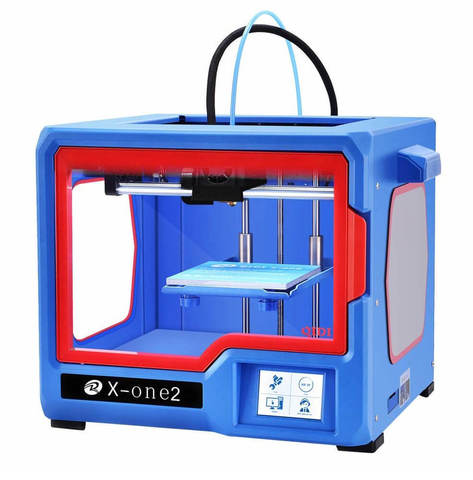 Monoprice Voxel (Best Value)
Monoprice Voxel (Best Value) 3D Printer Type: FDM | Materials: PLA, PLA+, ABS, TPU, TPE, TPC & PETG | Build Volume: 150 x 50 x 150 mm
The Monoprice Voxel is an easy to use and affordable enclosed 3D printer that comes with the convenience of automatic print bed leveling and quick nozzle changes.
Changing the nozzle on a Monoprice Voxel is an easy and quick process that requires no tools, unlike the awful chore it can be with some other printers. And with the Assisted Leveling feature, all you have to do is tap the touchscreen to level the print bed, which really saves a lot of time having to tweak the bed yourself.
It also has Polar Cloud and an HD camera for monitoring your print when you’re away from your printer. Might be a handy feature for those with social life (what’s that? Never heard of it.)
Also, it comes with a pretty decent printing speed of 60mm/s — not super fast but not super slow, good enough for home usage.
There have been some reported problems with Voxel’s software, like crashing, as well as the Wifi connectivity feature having some issues. So keep that in mind if you choose to purchase this printer.
Generally, with a print bed of 150 x 150 x 150 mm and layer thicknesses down to 50 microns, this is a great affordable printer if you want to print small and high-quality objects.
- Easy to use
- Layer thickness down to 50 microns
- Affordable
- Automatic bed leveling and quick nozzle changeovers
- Cloud capabilities
- Flaky firmware that needs some work
Check Latest Price
3. Raise3D Pro2 (Premium Choice)
Raise3D Pro2 (Premium Choice) 3D Printer Type: FDM | Materials: PLA, ABS, HIPS, TPU, Nylon, PETG, & ASA | Build Volume: 254 x 152 x 170 mm
None of the printers on this list big enough for you? We raise you the Raise3D Pro2, which is a professional, large-format printer that comes with a dual extruder and a humongous build plate at 305 x 305 x 300 mm.
This printer is BUILT for production. The Raise3D Pro2 yields amazing print quality, as well as layer thicknesses down to just 10 microns. It comes with interchangeable nozzles for different filament sizes, as well as a dual extruder for multi-material 3D printing.
You can print a huge variety of materials, like PLA, ABS, HIPS, TPU, Nylon, PETG, and ASA. PHEW, that was a mouthful. And it comes with its own slicer.
The ideaMaker software is a really thorough, powerful, and easy-to-use slicer that allows you to automatically generate supports for your prints as well as easily fine-tune areas of your print.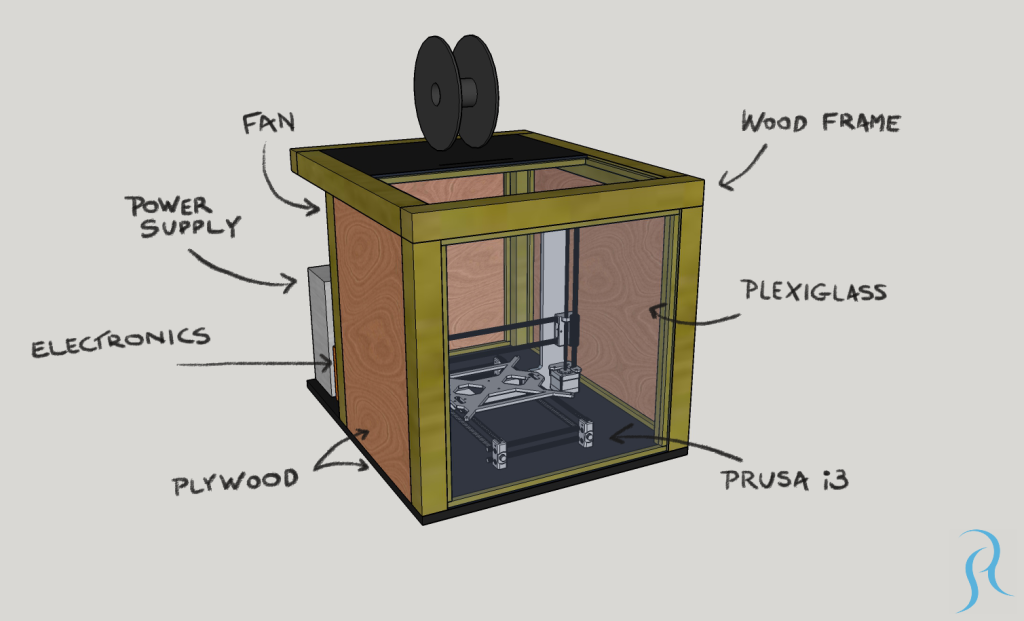
Also, we’ve got a HEPA air filter to keep out 3D printing fumes and keep your surroundings nice and clean. So if you want a 3D printer with production at the focus, this is your printer.
- Dual extruder
- HEPA filter for filtering out fumes
- 10 microns layer thickness
- Expensive, and we mean expensive
Check Latest Price
4. Dremel DigiLab 3D45-01 (Best Mid-Range 3D Printer)3D Printer Type: FDM | Materials: PLA, ECO ABS, PETG & Nylon | Build Volume: 254 x 152 x 170 mm
Looking for a solid printer to invest in for home usage? Or perhaps you’re looking for a good printer for professional or educational purposes? Try the Dremel DigiLab 3D45-01. To sum it up succinctly, it’s pretty gosh darn good.
To sum it up succinctly, it’s pretty gosh darn good.
The Dremel DigiLab 3D45 yields an amazing print resolution of 50 microns and layer thicknesses down to 50 microns. It’s got a respectable build volume at 254 x 152 x 170 mm — a pretty big canvas to print nearly anything you want within those constraints.
We’ve got a 5” full-color touchscreen, which is pretty nice but expected at this price range.
The DigiLab also has a built-in educational ecosystem that teaches you math and science concepts through 3D printing projects (great in a teaching setting).
It’s got an enclosed glass frame and a carbon filter for fumes and odors (not gonna use the unprofessional term here). The filter’s a nice addition to make the printer ideal for using indoors.
The Dremel DigiLab works best with its own filaments rather than 3rd party ones, so keep that in mind if you’re gonna buy this printer — it’s not for experimenting with other types of filaments but works solidly when you use its proprietary materials.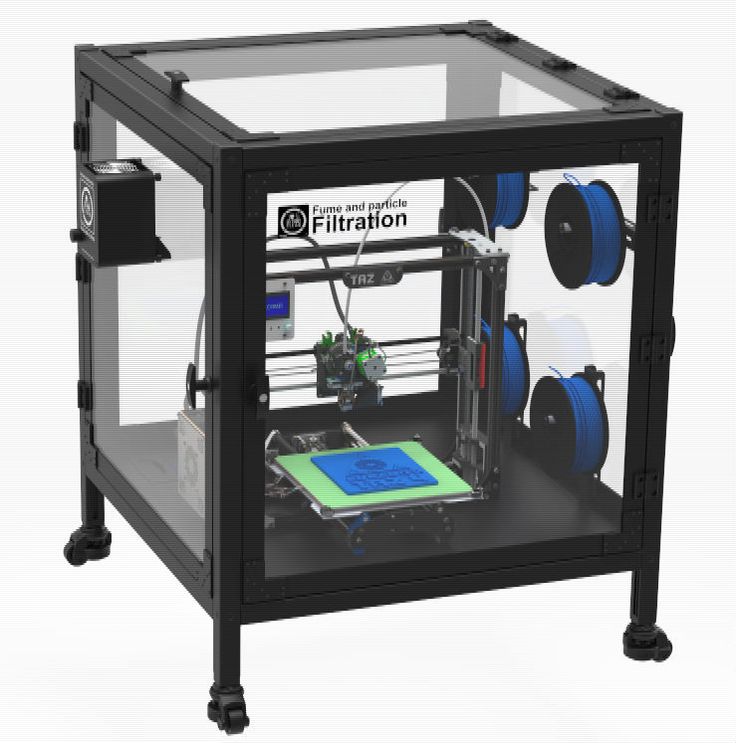 If you want a solid, high-quality printer for your classroom or lab (and can afford it), go for the DigiLab.
If you want a solid, high-quality printer for your classroom or lab (and can afford it), go for the DigiLab.
- Large build area
- 50 microns print quality
- Carbon filter for 3D printing fumes and odors
- Expensive
- Doesn’t work well with 3rd party materials
Check Latest Price
5. Flashforge Adventurer 3 Lite (Best Budget)3D Printer Type: FDM | Materials: PLA, ABS, Metal & Wood | Build Volume: 150 X 150 X 150 mm
If you want to start 3D printing on a budget, listen up! The Flashforge Adventurer 3 Lite is perfect for you — it yields amazing printing performance and is a super affordable option, especially for beginners.
For starters, let’s sort out the difference between Adventurer 3 and Adventurer 3 Lite. Unlike its predecessor, the Lite does not have a camera, but this also makes it one of the most affordable, well-designed 3D printers out there.
It comes with a color touchscreen — quite nice considering the low price tag of this printer. It also has a really sturdy, well put-together, and solid build.
We’ve got a quick-change nozzle system which makes nozzles a breeze to remove and replace, and a thin, removable build plate that’s easy to just bend and snap your print off of it.
It’s way easier to deal with than scraping your print off the build plate, which can be like playing Fruit Ninja except your fingers are the fruits. Yeah. Be careful with those scrapers. Luckily, there’s no need for all that with the Lite.
The Lite’s got a build volume of 150 x 150 x 150 mm — which isn’t much compared to some of the other options on this list, but it’s plenty to work with if you print small to medium-sized objects.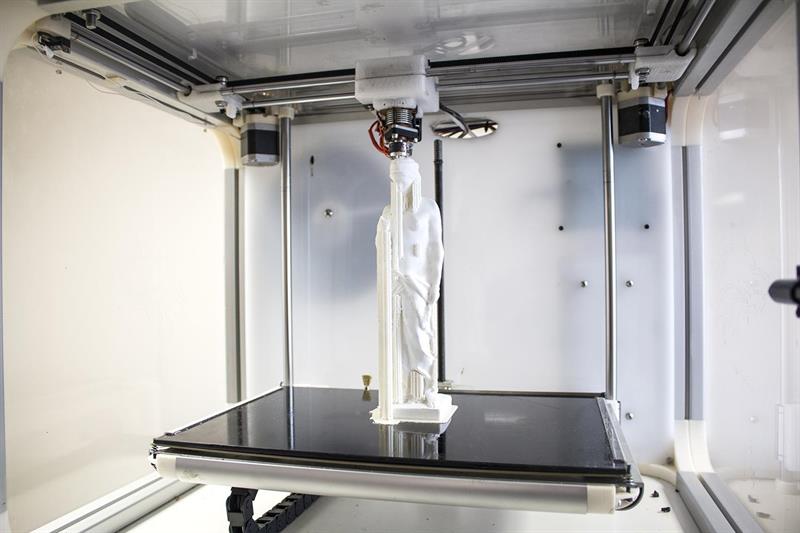
The Lite comes with FlashPrint, a robust 3D slicer by Flashforge that comes in basic and advanced modes. You can get some amazing details with this printer, and for the price, it’s a steal. If you’re looking for a great budget printer, the Adventurer 3 Lite is it.
- Affordable
- Has a color touchscreen
- Flexible build plate for easy and non-damaging print removal
- Quick-change nozzle system
- Small build volume
Check For Official Website
Check Latest Price
6.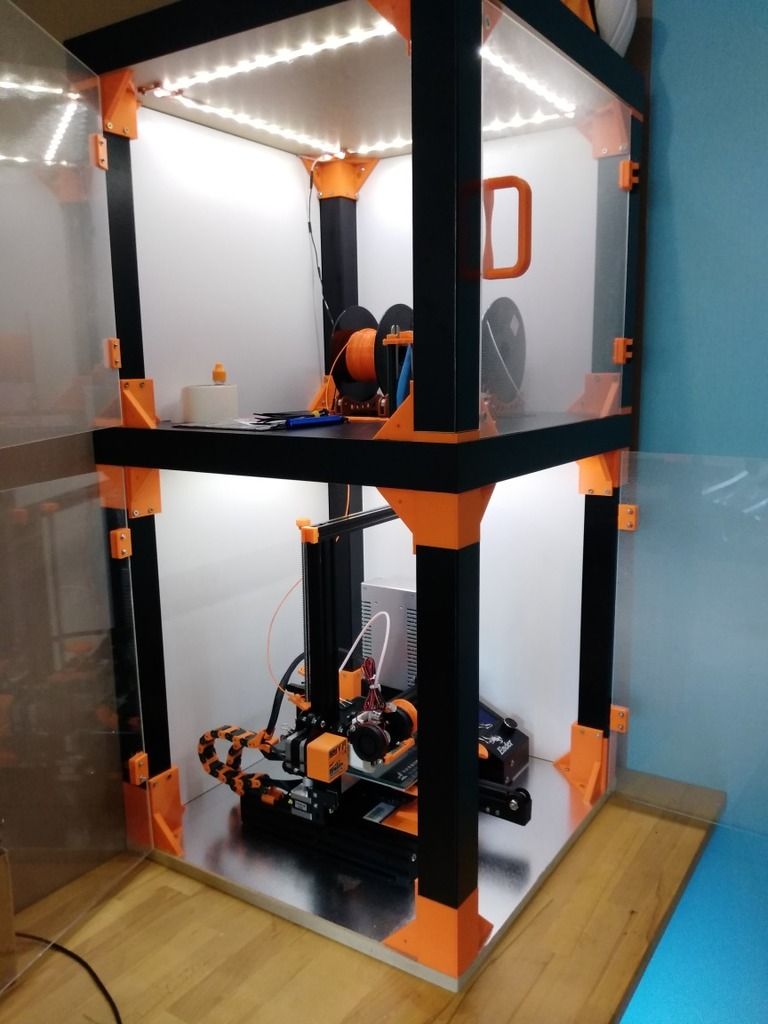 Qidi Tech i-Mate (Most Reliable)
Qidi Tech i-Mate (Most Reliable) 3D Printer Type: FDM | Materials: PLA, ABS, TPU & PETG | Build Volume: 260 x 200 x 200 mm
Yet another one of these printers? You’ve got to be Qiding! (Yes, I made the same joke again.)
Well, the Qidi Tech i-Mate is no laughing matter. In fact, it’s a robust and reliable enclosed 3D printer that’s on the cheaper end compared to similar printers. There’s a sizable build volume at 260 x 200 x 200 mm for printing medium to large-sized objects.
And with a layer thickness of 50 microns and up, it offers high-quality and detailed printing at an affordable price. Like the Qidi Tech X-Max, its print bed can go up to 120 degrees Celsius. Because of this, the Qidi Tech i-Mate is great for printing with a variety of filaments, including the ones that are notoriously tricky to work with like nylon.
We’ve also got a Wifi connected touchscreen. This isn’t something present on every 3D printer, so it’s nice to have that rather than an old fashioned display and dial.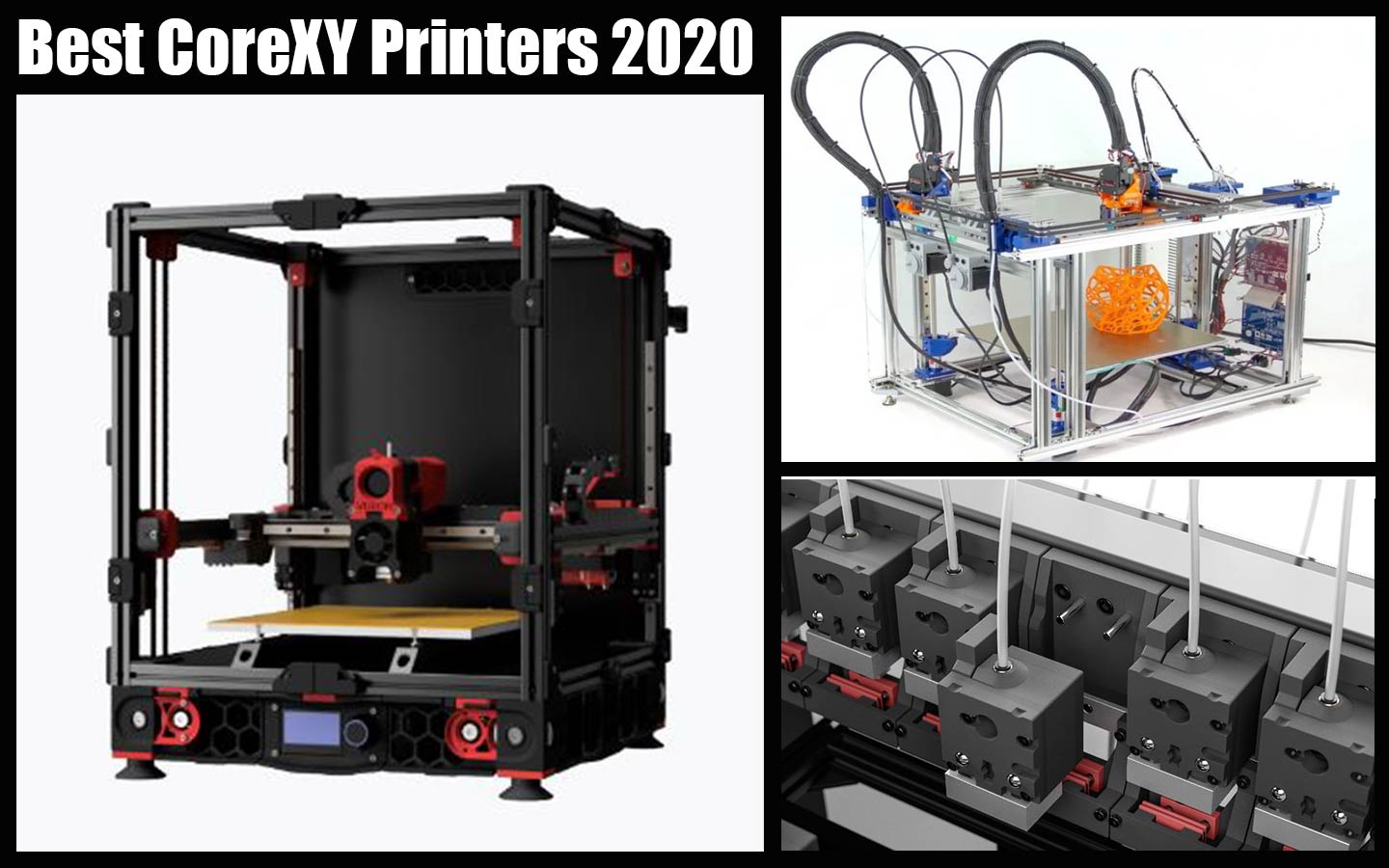
Sadly, the i-Mate doesn’t have automatic bed leveling, but there’s always the option of getting a BL-Touch upgrade for that.
If you want a robust and sturdy machine yielding high-quality prints on a budget, the Qidi Tech i-Mate is for you.
- Affordable
- Sturdy build
- Touchscreen and WiFi connectivity
- Minimum layer height of 50 microns
- Works great for higher-temp filaments
- Manual bed leveling
Check Official Store
Check Latest Price
7. Dremel DigiLab 3D40-FLX-01 (Best PLA-Specific Printer)
Dremel DigiLab 3D40-FLX-01 (Best PLA-Specific Printer) 3D Printer Type: FDM | Materials: PLA Only | Build Volume: 254 x 152 x 170 mm
The Dremel DigiLab 3D40 Flex is a version of the DigiLab 3D45 that’s optimized for PLA filaments. It’ll also cost you less than the 3D45, as it’s restricted to being able to use PLA only.
The 3D40 Flex comes with a nice and responsive 4.5” touchscreen — always handy, especially for the youngins who may not be experienced with 3D printing yet.
With connectivity options including Wifi, Ethernet, and USB. The DigiLab 3D40 Flex can connect to Dremel Print Cloud, where you can prepare a file for printing and launch print jobs.
There’s a bunch of printer settings that we can choose from. We’ve got the High-Quality setting (100 microns), Medium Quality (200 microns), Low Quality (300 microns), and High Speed, which prints at 340 microns and is suitable for draft or test printing.
Dremel also plans to introduce the option to print at 50 microns in a future software update.
We’ve also got the same DigiLab 3D Slicer software as we do in the 3D45 — powerful and easy to use. So if you aren’t necessarily looking to experiment with filament types, but want an easy to use printer for PLA-only prints, this printer is the one to go for.
- Big build area
- High-quality printing
- Cheaper than the Dremel 3D45
- Can only use PLA
- Still pricey
Check Latest Price
Advantages and Disadvantages of Enclosed 3D Printers
Source: Youtube MatterHackersEnclosed 3D printers often allow for superior print quality in comparison to open-frame printers.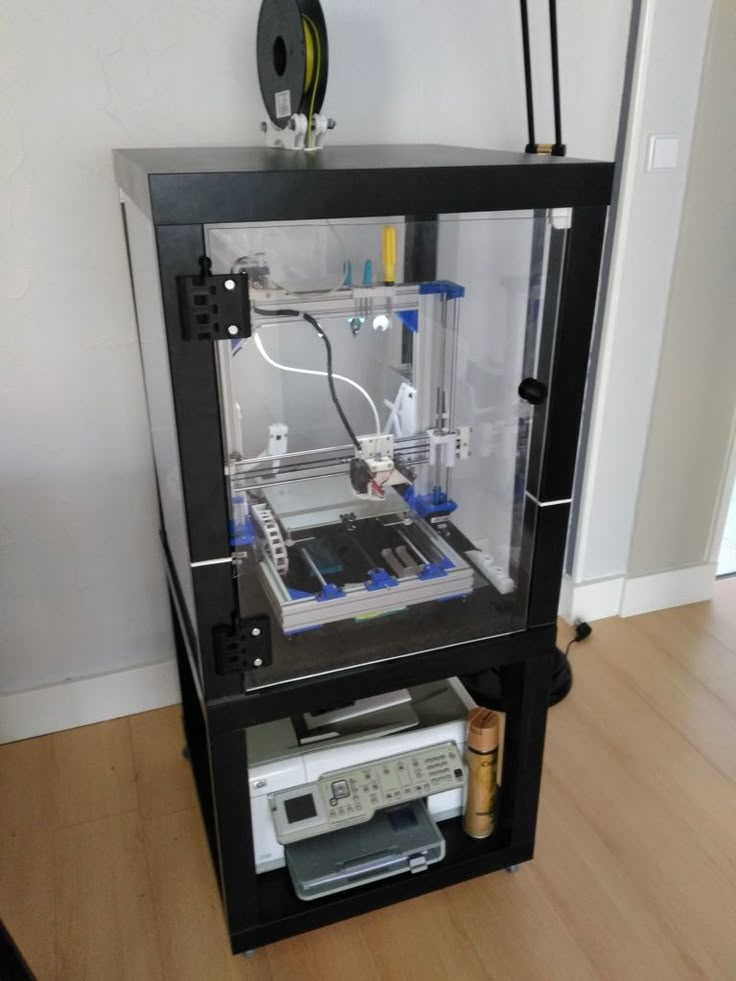 This is because an enclosed print chamber creates an even and hot ambient temperature that helps prints develop better.
This is because an enclosed print chamber creates an even and hot ambient temperature that helps prints develop better.
Sort of like a 3D printing oven.
They’re also safer for any children or pets, and because they’re closed, they can often be less noisy than your traditional open-frame printer.
A disadvantage of enclosed 3D printers is that it can be quite difficult to clean the inside workings or even change the parts. If you’re used to tinkering with your printers, enclosed 3D printers don’t quite give you the opportunity to do that.
Features to Consider:
Printing Technology
FDM, SLA, and DLP are the main printing technologies available out there. With FDM 3D printers, you use filaments to print the final product, while SLA and DLP require the usage of resins.
SLA and DLP printers are always enclosed. However, FDM printers are often open-frame, with enclosed options or enclosures sold separately.
Generally, if you’re a 3D printing newbie, FDM is your best bet.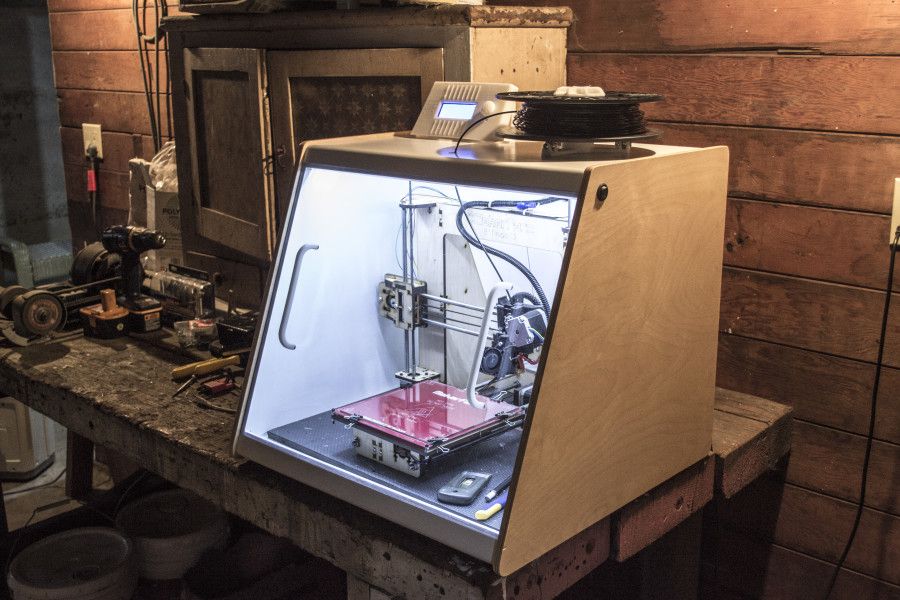 It’s affordable and yields good quality prints — and it’s easy to learn and work with. If you are a professional or an experienced 3D printer user who requires really fine detail, go for DLP or SLA 3D printers depending on your budget and needs.
It’s affordable and yields good quality prints — and it’s easy to learn and work with. If you are a professional or an experienced 3D printer user who requires really fine detail, go for DLP or SLA 3D printers depending on your budget and needs.
Build Volume
Bigger build volume means bigger prints. Smaller build volume = smaller prints. Even the smallest build volume on this list should be good enough to work with for printing figurines or smaller objects. If you want to print consistently large things, it’s a good idea to go for a large printer. (Wow! Mind-blowing.)
Layer Resolution
Layer resolution, also known as layer thickness, determines the smoothness and surface quality of your print.
Layer thicknesses usually start from 300 microns and go down all the way to just 10 microns on some really professional printers. A layer thickness of 100 microns is good enough for nicely-detailed prints. If you want even more detail you can go for 50 micron settings if available, but be warned, your print will take quite some time to finish.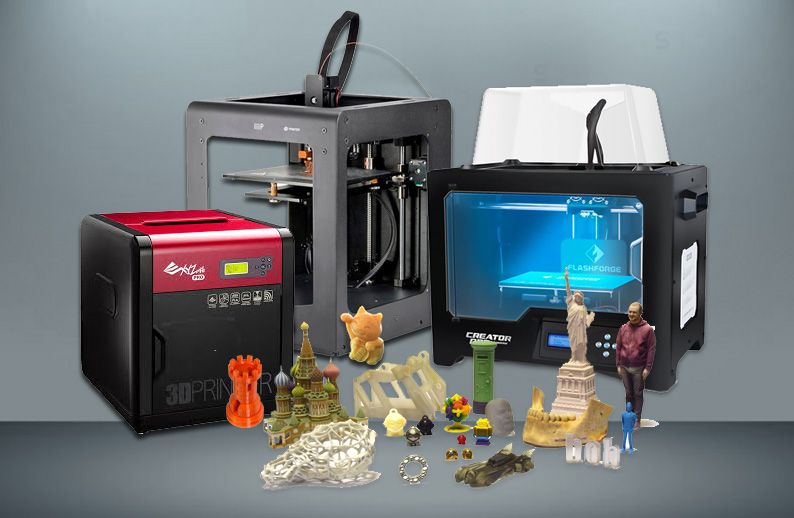
Print Speed
A good 3D printing speed starts at 40mm/s and up. Most printers on the market have a decent print speed, but if you are looking to get a 3D printer for work or production, you’ll need higher speeds, perhaps 100 mm/s and up.
Check our article on the fastest 3D printers known to man to learn more.
Supported Materials
Each printer supports different materials and filaments. This depends on the maximum temperatures of the hot end of the extruder, as well as the print bed.
PLA and similar filaments don’t need high temperatures, but filaments like nylon and TPU print best with high temps as well as an enclosed environment to develop properly.
Connectivity
Different printers offer different connectivity options, like Wifi, USB connectivity, and Ethernet. Some printers may not support Wifi and only USB. Obviously, Wifi and Ethernet are convenient, but we still live in an age of thumb drives and it’s not that hard to put your desired printing file on a thumb drive one and load it up on the printer.
Heated Print Bed
Print beds are an important factor because once your print is finished, either you can easily pop it off or you’ll have to use a scraper. Scrapers are dangerous and can eventually cause damage to the bed (or your thumb).
If you want to avoid this, look for printers with flexible steel plates for easy print removal.
Also, heating is a huge factor in determining the quality of a print. An evenly heated print bed means a higher quality print.
Extruder Quality
An extruder is how we refer to the series of parts in your 3D printer that are responsible for working with the filament. Simply put, it’s important because your 3D printer’s extruder determines the quality of the extrusion. And the better the extrusion, the better quality your print is.
Dual Extrusion
If you’re looking to print different colors or materials at the same time, dual extrusion is gonna do that for you. You can alternate colors as well as print supports with water-soluble materials, which makes for super easy post-processing (dissolve the material in water by keeping your print in water for a few hours).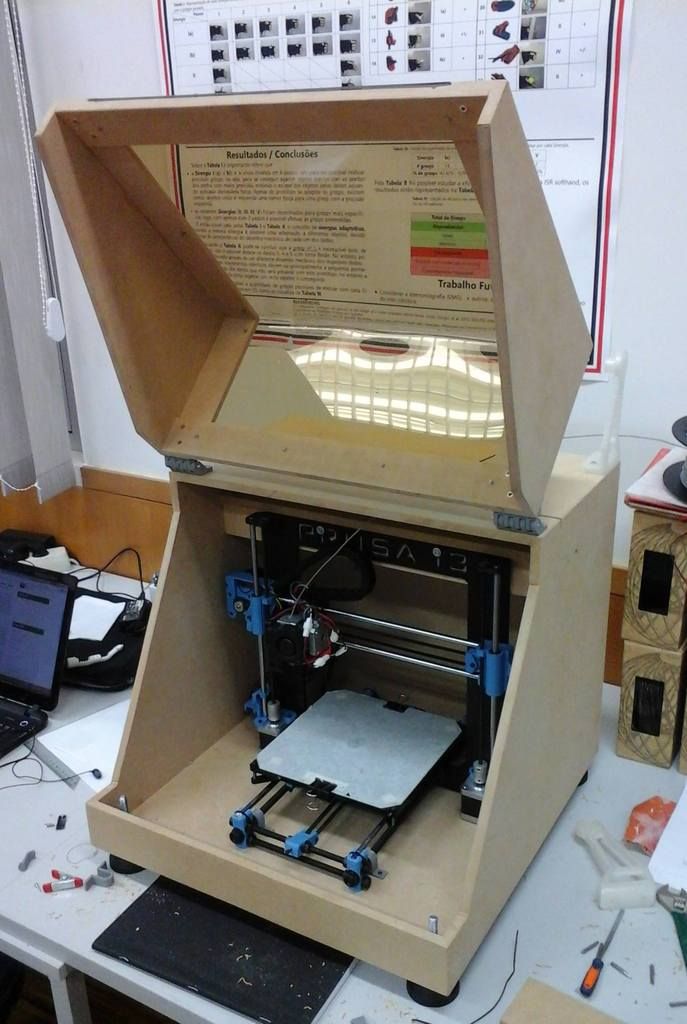
Dedicated Slicer or Open Source
3D printing slicers are the software you work with to design and tweak your 3D print. There are two types of such software — we’ve got open-source slicers and then we’ve got proprietary slicers. A lot of 3D printers use their own specific versions of Cura, an open-source slicer.
As long as the software is easy to use, that’s what’s important and makes all the difference in the 3D printing process. And generally, Cura offshoots are powerful yet intuitive software that have different modes for beginners and experts.
Touch Screen
Touchscreens are a really important factor in a 3D printer. Their convenience is not easily overlooked, though it might be tempting to just dismiss it as an afterthought or as an “extra accessory” that’s not required.
Especially if you are new to 3D printing, it helps a LOT to have easy controls at your fingertips, and it can make all the difference in the 3D printing process and your experience of it.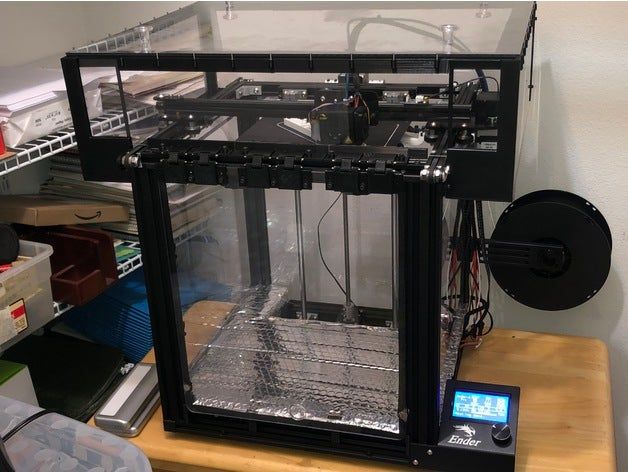
Price
This is one of the most important factors to consider.
3D printers Are. An. Investment. And you want to make sure you get the best one you can for your money. There are cheaper 3D printers, but remember there will always be some trade-offs compared to higher-quality printers.
That being said, the most important thing is to know exactly what you want from a printer, and then look for the closest match available to you in the market within your budget range.
Difference Between Fully and Partially Enclosed 3D Printers
Partially-enclosed printers are, as the name implies, partially enclosed. (Truly thought-provoking). Such printers aren’t ideal for ABS and PLA, because they’re not fully enclosed and can’t make the ideal ambient temperature required for those materials.
However, they do provide some safety, so if that’s the main feature you want in a printer rather than the ambient temperature that a full enclosure provides, then yes, they’re safe. However, since they’re partially enclosed, you may smell fumes.
However, since they’re partially enclosed, you may smell fumes.
Is an Enclosed 3D Printer Safe?
Source: Youtube Spot PrinterThanks to the enclosure, enclosed 3D printers are much safer than their open-frame counterparts. For one, you don’t have to breathe in all the fumes. Also, hot and moving parts are kept safely out of reach.
So yes, enclosed 3D printers are safe, and they are a must-have if you have kids or animals in the place you plan to 3D print in.
So Which Is the Best Enclosed 3D Printer?
If you want a good budget option for an enclosed 3D printer, the Lite 3 is amazing for the price. Also consider the Monoprice Voxel, which is affordable and a decent printer.
We recommend the Qidi Tech X-Max as the best overall enclosed 3D printer if you want nice, high-quality, and large prints. Want even larger prints and a professional machine for production? Go for the Raise3D Pro2.
If you want a great mid-range printer, the Dremel DigiLab 3D45 is a solid printer that makes great, high-quality output.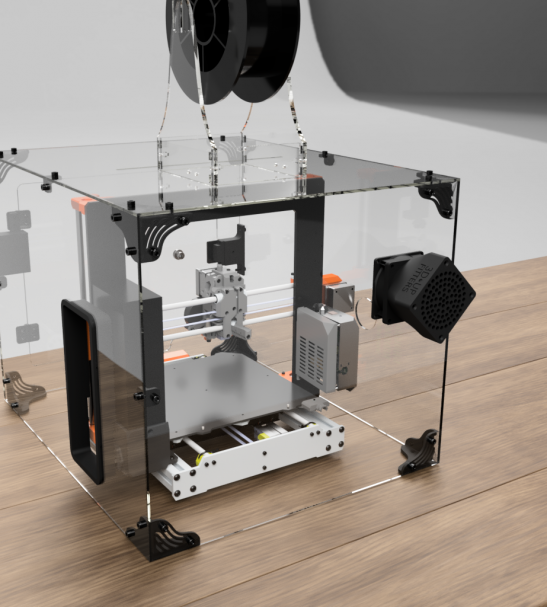 The Dremel DigiLab 3D40-FLX-01 is a slightly more affordable version of this printer that you can go for if you’re fine with printing exclusively with PLA filament.
The Dremel DigiLab 3D40-FLX-01 is a slightly more affordable version of this printer that you can go for if you’re fine with printing exclusively with PLA filament.
8 Best Enclosed 3D Printers 2022 (All Price Ranges)
Enclosed 3D printers keep the cool air from getting to your print, causing warping or other issues. For basic filaments like PLA, 3D printer enclosures don’t make all the difference, but for trickier filaments like ABS and Nylon, they’ll save you time and time again.
Most cheap 3D printers are open 3D printers — they have no frame or enclosure (you can sometimes buy them separately) and print in the open air. Almost all 3D printer kits, like the Ender 3 and CR-10, are open air 3D printers (though you can buy Ender 3 enclosures).
However, this can cause problems. ABS, a commonly used 3D printer filament, warps when not cooled slowly. Moreover, enclosed 3D printers keep the hot and dangerous-to-touch 3D printer parts away from yours and anyone else’s prying hands. This is especially important around children, making enclosed 3D printers some of the best 3D printers for kids.
This is especially important around children, making enclosed 3D printers some of the best 3D printers for kids.
Best 3D printers with enclosures
| Name and brand | Build Volume (mm) | Price | Where to buy | Alternative purchase option |
|---|---|---|---|---|
| Monoprice Voxel | 150 x 150 x 150 | $449 | Amazon here | Matterhackers here |
| Qidi Tech X-Pro | 230 x 150 x 150 | $499 | Amazon here | 3DJake UK & Europe |
| Bibo 2 | 216 x 187 x 160 | $679 | Amazon here | |
| Flashforge Creator Pro / Max | 227 x 148 x 150 | $699 / $879 | Amazon here | 3DJake UK & Europe |
| Dremel 3D45 | 254 x 152 x 170 | $1,599 | Matterhackers here | Dynamism Store here |
| Raise3D E2 | 330 x 240 x 240 | $3,499 | Matterhackers here | Dynamism Store here |
| Raise3D Pro2 / Pro2 Plus | 305 x 305 x 300(600) | $3,999 / $5,999 | Matterhackers here | Dynamism Store here |
| Ultimaker S5 | 330 x 240 x 300 | $5,995 | Dynamism Store here | Matterhackers here |
3DSourced is reader-supported.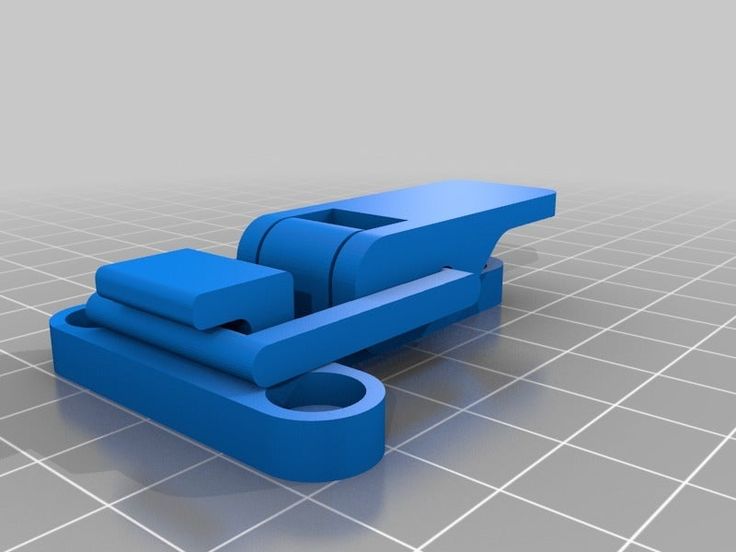 When you buy through links on our site, we may earn an affiliate commission. Learn more
When you buy through links on our site, we may earn an affiliate commission. Learn more
Best enclosed 3D printers under $1,000
Flashforge Adventurer 3 Lite – cheapest enclosed 3D printer
- Price: $339 — Available at Flashforge Official store here / Available at Amazon here
- Build volume: 150 x 150 x 150 mm
The Flashforge Adventurer 3 Lite is a compact and quiet, fully enclosed beginner-friendly printer that offers frictionless out-of-the-box printing. There’s minimal setup involved, bar a well-guided five-point assisted calibration process, which makes it a top choice for first-timers or students looking to cut their 3D printing teeth free of hassle.
It’s modeled almost exactly on the full-fat Adventurer 3, minus a built-in camera and filament run-out detector. These minor features don’t detract significantly from the easy printing experience on offer here.
Aside from the sleek enclosed design, the Flashforge Adventurer 3 Lite has everything you need to work with thorny materials like ABS: a flexible, heated bed with a top temperature of 100°C and a max nozzle temperature of 240°C. With these features, you can also dabble in more exotic heat-sensitive filaments such as metal-fill, wood-fill, and others.
With these features, you can also dabble in more exotic heat-sensitive filaments such as metal-fill, wood-fill, and others.
It also has a robust selection of connectivity options, including Wi-Fi and remote print monitoring, thanks to FlashForge’s 3D Cloud Print. A 150 x 150 x 150 mm build volume makes for a tight print area, one of the few complaints that stick when assessing the Flashforge Adventurer 3 Lite. You won’t have much luck printing bulky, towering parts, but this is easily remedied by printing in parts instead.
It’s also worth pointing out that the filament bay mounted on the side of the printer, while practical, isn’t geared to accommodate all types and brands of filament. You may need to fashion an external holder if your third-party filament of choice won’t fit.
Key points:
- Enclosed chamber
- Reliable, beginner-friendly printer
- Wi-Fi connectivity
- Materials: PLA, ABS, Ultra Strong PLA, PLA Color Change, Metal-Filled, Wood, and High Speed PLA
- Price: $449 — Available on Amazon here / Available on Matterhackers here
- Build volume: 150 x 150 x 150 mm
The cheapest enclosed 3D printer we recommend, the Monoprice Voxel is one of the best 3D printers for beginners. It’s super simple to set up (within 10 mins!), is easily operable via the touchscreen, can print via WiFi, and comes with 8GB onboard memory for storing 3D printer files. It comes with a few 3D models on file as well as some filament to get you started, so you can really go from unboxing to printing in minutes.
It’s super simple to set up (within 10 mins!), is easily operable via the touchscreen, can print via WiFi, and comes with 8GB onboard memory for storing 3D printer files. It comes with a few 3D models on file as well as some filament to get you started, so you can really go from unboxing to printing in minutes.
If you’re brand new to 3D printing and not too technical, the assisted leveling reduces expertise to just a tap. It also comes fully assembled so you don’t need any DIY skills, surprising considering most printers in this price range are 3D printer kits. It can also connect to the Polar Cloud, allowing you to remotely control and monitor your printer, and even do so for multiple printers simultaneously.
Key points:
- Cheap enclosed 3D printer
- Beginner friendly
- WiFi printing and touchscreen on an affordable machine
- Materials: ABS, PLA, PETG, Flexibles
- Price: $500 — Available on Amazon here / Available on 3DJake UK & Europe here
- Build volume: 230 x 150 x 150 mm
One of the most popular low cost 3D printers of the last year, the Qidi Tech X-Pro offers reliability, accuracy, dual extrusion, and an effective enclosed printing area, all at $500.
Layer thicknesses start at 0.05mm, and the printer can print at speeds between 30 and 150mm/s — though at these high speeds print quality will noticeably deteriorate. It’s Mac and Windows compatible, and can print via WiFi, as well as via USB or ethernet connections.
The flexible, removable build plate makes for easy print removal with minimal damage, and it comes with Qidi Tech’s own QidiPrint 3D slicer. Overall, it’s one of the best enclosed 3D printers for $500.
Key points:
- Large 4.5 inch touchscreen for ergonomic printing
- Flexible build plate
- WiFi printing and dual extrusion for $500
- Materials: ABS, PLA and PETG
Flashforge Creator Pro 2 – Top Affordable IDEX Printer
- Price: Available at Flashforge Official store here / Check price on Amazon here
- Build volume: 200 x 148 x 150 mm
A well-tooled refresh of the classic Creator Pro, the Flashforge Creator Pro 2 offers all the balmy goodness of an enclosure with features you wouldn’t expect in the $600 to $700 range.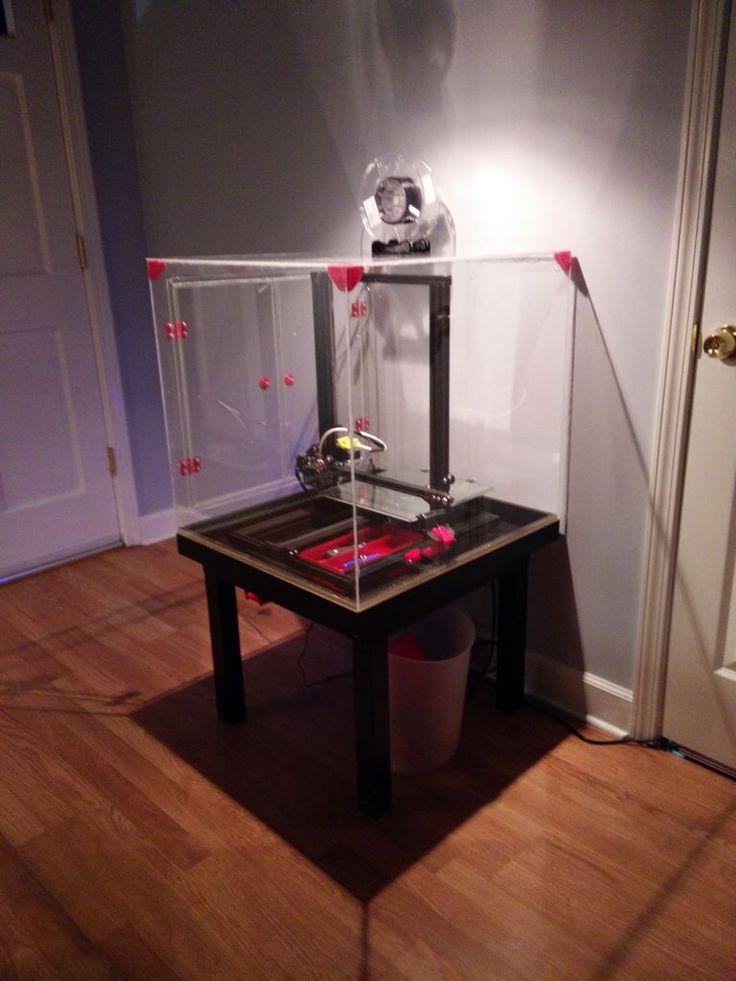 We see it as a perfect second printer for a maker that’s already tackled that initial learning curve on a budget FDM kit and is now looking for something more versatile and feature-rich.
We see it as a perfect second printer for a maker that’s already tackled that initial learning curve on a budget FDM kit and is now looking for something more versatile and feature-rich.
While the Flashforge Creator Pro 2 features a sturdy, well-built enclosed print chamber suitable for both ABS and PLA thanks to the removable acrylic top cover, it’s the independent dual extruder system that sets it apart from the other best enclosed 3D printers out there.
An IDEX system is almost unheard of at this price, giving makers the possibility to spice things up with mirror prints, duplicate prints, soluble support structures, and even printing multiple materials or colors simultaneously. It’s one for complex prints with vertiginous overhangs or an ideal tool to help a teacher pump out as many student-designed prints as fast as possible.
These two central points aside, the Flashforge Creator Pro 2 rounds off the offering with a touchscreen interface, a 200 x 148 x 150 mm build volume, and compatibility with PLA, Pearl PLA, ABS, ABS Pro, PVA, and HIPS materials.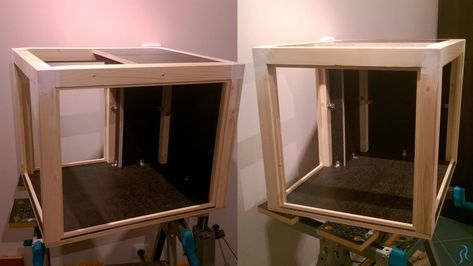
It’s worth noting that Flashforge made the unfortunate choice of anchoring the Creator Pro 2 to its in-house FlashPrint slicer. It does the job well enough but doesn’t have the versatility of an open-source software kit like Cura. Not necessarily a deal-breaker, especially for 3D printing newcomers or educators that want straightforward software and pre-loaded settings specifically tuned to work with the Creator Pro 2 from the get-go.
Key points:
- Affordable independent dual extruder system
- Fully-enclosed print chamber
- Materials: PLA, Pearl PLA, ABS, ABS Pro, PVA, and HIPS
- Price: $679 — Available on Amazon here
- Build volume: 216 x 187 x 160 mm
Full of character and affordable for hobbyist makers, the Bibo 2 offers 50-micron accuracy, dual extrusion, and WiFi printing, all at well under $1,000.
Though not an IDEX printer, this enclosed 3D printer still offers copy printing modes for printing two of the same objects simultaneously. It has an easy to use touchscreen — not a given in this price range — and has filament run out detection to avoid ruining prints.
It has an easy to use touchscreen — not a given in this price range — and has filament run out detection to avoid ruining prints.
As well as a 3D printer enclosure for effective ABS and Nylon 3D printing, the Bibo is built in a stable and strong aluminium frame, minimizing unwanted vibrations that can slightly affect performance and print quality. Overall, for the price it’s a great enclosed 3D printer — and it can also come with a laser engraver kit.
Key points:
- WiFi printing, dual extrusion, and a touchscreen, all for just over $500
- 50-micron minimum layer heights
- Claims to be able to print Polycarbonate, but also says max temperature is 270C
- Materials: PLA, ABS, HIPS, flexible filaments, PETG, Nylon, PC, Carbon fiber
Best prosumer enclosed 3D printers
Dremel 3D45- Price: $1,599 — Available on Matterhackers / Available on Dynamism / Available on Amazon
- Build volume: 254 x 152 x 170 mm
Accurate, versatile and perfect for teaching 3D printing in schools, the Dremel 3D45 builds on almost a century of Dremel manufacturing excellence. Boasting up to 50-micron accuracy, connectable via WiFi as well as by USB or ethernet cable, and compatible on Mac or Windows computers as well as iPads, the Dremel Digilab 3D45 perfectly complements any school or business prototyping environment.
Boasting up to 50-micron accuracy, connectable via WiFi as well as by USB or ethernet cable, and compatible on Mac or Windows computers as well as iPads, the Dremel Digilab 3D45 perfectly complements any school or business prototyping environment.
The heated plate means it can print Nylon and Eco-ABS, and the built-in HD camera makes for easy remote monitoring of print progress, which can be easily done via their cloud 3D printing software.
If you do run into any problems, Dremel’s USA-based support are on hand to help you. Overall, it’s a reliable and accurate enclosed 3D printer that offers good build volume and results for the price.
Key points:
- Effective auto leveling system
- Highly-rated customer support
- Versatile
- Materials: PLA, PETG, Eco-ABS, Nylon
- Price: $3,499 — Available on Matterhackers / Available on Dynamism / Available on Amazon / 3DPrima Europe here
- Build volume: 330 x 240 x 240 mm
Raise3D’s large, enclosed 3D printer brings IDEX dual extruder 3D printing to their already impressive 3D printing range. IDEX 3D printer extruders can move independently, greatly increasing print speeds and efficiency, especially for printing multiple similar or identical parts.
IDEX 3D printer extruders can move independently, greatly increasing print speeds and efficiency, especially for printing multiple similar or identical parts.
The E2 features two main modes:
- Mirror mode: 3D prints inverted mirror versions of your model, for example a left and right-footed shoe sole, simultaneously.
- Duplication mode: uses both extruders in synchrony, printing two identical objects at the same time and doubling printing efficiency.
The E2’s 3D printer enclosure keeps the heat in, and everything else out. If the door is opened during printing, progress is immediately paused to ensure nobody is burned or harmed by the extruder or heated bed. The E2 also has an effective air filtration system, removing melted plastic particles and aromas, as well as filament run out sensors and power outage recovery features.
Key points:
- Build volume drops to 295 x 240 x 240 mm if using the dual extruder
- Useful Mirror & Duplication modes
- Built-in safety measures
- Materials: PLA, ABS, HIPS, PC, TPU & TPE, PETG, Nylon, PP, ASA, PVA, Glass-infused, Metal-filled, Carbon fiber-filled, and wood-filled filaments
Best upper-range 3D printers with enclosures
Raise3D Pro2 / Pro2 Plus- Price: $3,999 / $5,999 — Available on Matterhackers here / Available on Dynamism here / Available on Amazon here
- Build volume: 305 x 305 x 300 (605) mm
A true workhorse 3D printer with full enclosure, the Raise3D Pro2 range offer incredible accuracy, material compatibility, great workflow, and a host of other key features.
The standard Pro2 already features a very large build area, with the Pro2 Plus expanding the z-axis range up to up 605 mm tall parts. The extruders can reach 300C for even the toughest filaments like PC, and the dual extruders make for effective soluble support printing as well as 3D printing multiple colors.
With minimum layer heights of 0.01mm possible, the Pro2 enclosed 3D printers can print incredibly crisp and intricately detailed parts. Switch out the nozzle for a smaller nozzle, and zone in on small details for a fantastic finish. The built-in camera makes monitoring prints easy, and the 7-inch touchscreen offers data and a simple to use overall workflow.
Key points:
- Dual extruder build volume: 280 x 305x 300 mm
- Complete printer: accurate, reliable, enclosed, versatile.
- Materials: PLA, ABS, HIPS, PC, TPU, Nylon, ASA, PETG, PVA, Glass, Carbon fiber, Wood
- Price: $5,995 — Available at Dynamism here / Available on Matterhackers here / 3DPrima Europe here
- Build volume: 330 x 240 x 300 mm
Capable of 3D printing industrial-grade parts with up to 20-micron layer resolutions, it doesn’t get much better than the Ultimaker S5.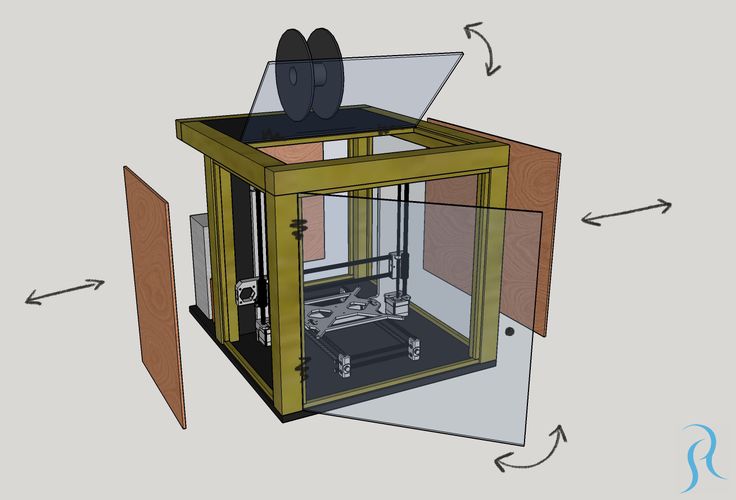 An enclosed 3D printer that becomes even more effective and safe with the S5 Pro Bundle, the S5 offers reliable and repeatable dual extrusion, at astonishing accuracy, even with abrasive filaments like glass and carbon fiber filaments.
An enclosed 3D printer that becomes even more effective and safe with the S5 Pro Bundle, the S5 offers reliable and repeatable dual extrusion, at astonishing accuracy, even with abrasive filaments like glass and carbon fiber filaments.
Though Ultimaker make their own filaments, the S5 is open and can be used with any 2.85mm filaments. It prints via WiFi as well as a variety of other methods, and can be monitored remotely via the built-in camera.
If you purchase the S5 Pro Bundle, you gain access to 24/7 automated material handling, air filtration and heat control for up to 6 filaments, as well as the Air Manager which further encloses the 3D printer.
Key points:
- Excellent precision and print quality
- Reliable and effective with many materials
- Pro Bundle makes it an even more effective enclosed 3D printer
- Materials: PLA, CPE, NYLON, ABS, Glass, Carbon fiber, PC, PVA, PP, TPU
Buyer’s Guide – What To Consider
Fully or Partially-Enclosed Chamber
Partially-enclosed printers are somewhat of an oddity as they don’t offer the ideal environment for printing either of the two main filament types, ABS and PLA.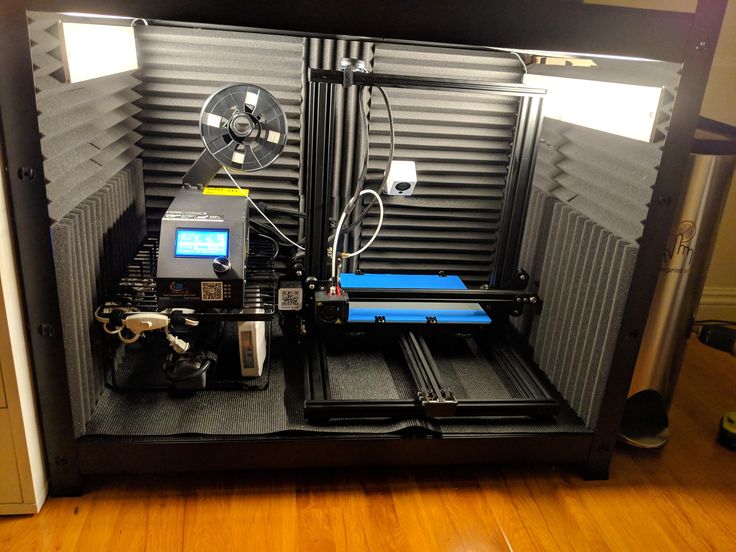 However, they provide an extra layer of safety, useful for education or makers with children. We recommend a fully-enclosed chamber if you plan to print using ABS and an open design if PLA is your filament of choice. If you’re looking to print with ABS and PLA, choose an enclosed printer with removable covers.
However, they provide an extra layer of safety, useful for education or makers with children. We recommend a fully-enclosed chamber if you plan to print using ABS and an open design if PLA is your filament of choice. If you’re looking to print with ABS and PLA, choose an enclosed printer with removable covers.
Build Volume
Build volume represents the printable area available to you on an enclosed printer. In other words, it’s a measure of the size and type of prints you can make. If you plan on making large prints or multiple copies, we recommend printers with large volumes, such as the Ultimaker S5.
Material Compatibility
By design, an enclosed 3D printer offers compatibility with a broader range of material types due to the capacity to maintain a higher temperature around prints and keep cool air out. ABS is by far the most common filament type for enclosed chambers, but you’ll also find printers that can tackle nylon, PC, and other heat-sensitive materials.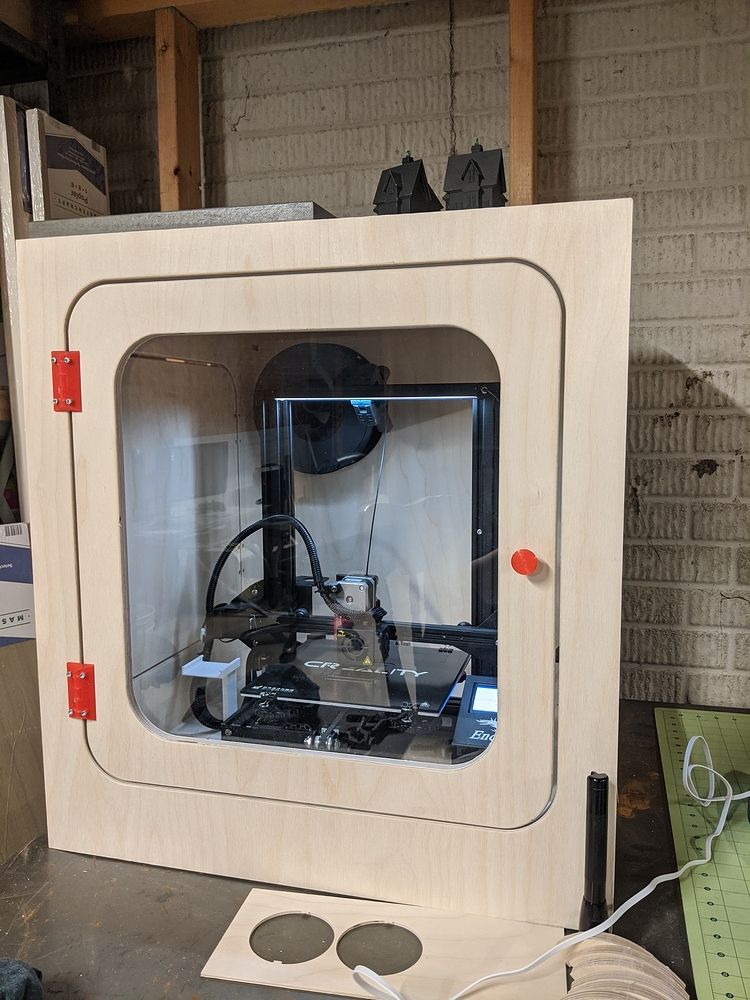 PLA is also a possibility as long as the printer’s covers are removable as the material requires cooler ambient temperatures for the best results.
PLA is also a possibility as long as the printer’s covers are removable as the material requires cooler ambient temperatures for the best results.
Heated Bed
Given that the whole point of an enclosed chamber is to provide a stable thermal environment to print trickier filament like ABS, a heated bed is a must-have. It helps provide an additional heat source directly below the print, which helps with layer adhesion and slows the cooling rate, which avoids unwanted imperfections like warping and curling.
Connectivity
Connectivity determines how you interact with the printer, whether sending sliced prints or fine-tuning settings. An SD card reader is more or less standard, as is USB in many cases, but for ease of use, nothing beats Wi-Fi connectivity and, by extension, cloud-based printing and monitoring.
Layer Resolution
Layer resolution indicates the lowest layer height a print can produce. Opt for a printer with a lower layer resolution for parts with more detail, such as the 20 microns on the Ultimaker S5. On an enclosed FDM printer, a 100-micron layer resolution is relatively standard and allows you to create a wide range of parts.
On an enclosed FDM printer, a 100-micron layer resolution is relatively standard and allows you to create a wide range of parts.
Filters
If you’re buying an enclosed chamber, chances are ABS is part of your printing plans. ABS is not just odorous but also produces potentially harmful fumes. Having a printer equipped with filters, either carbon or HEPA, helps extract the most toxic elements from the fumes. Additionally, we also recommend working with ABS in a well-ventilated space.
Touchscreen
For convenience, we recommend an enclosed 3D printer with a touchscreen. After all, we’re all accustomed to scrolling and swiping on our phones, so it makes sense to want the same functionality and familiar interface when working with a 3D printer. Most modern printers feature a touchscreen as standard.
Price
Enclosed printers tend to bump up the price as you pay for the extra manufacturing and design involved. But, with the ever-growing popularity of the race-to-the-bottom budget category, enclosed chamber printers are more affordable than ever before.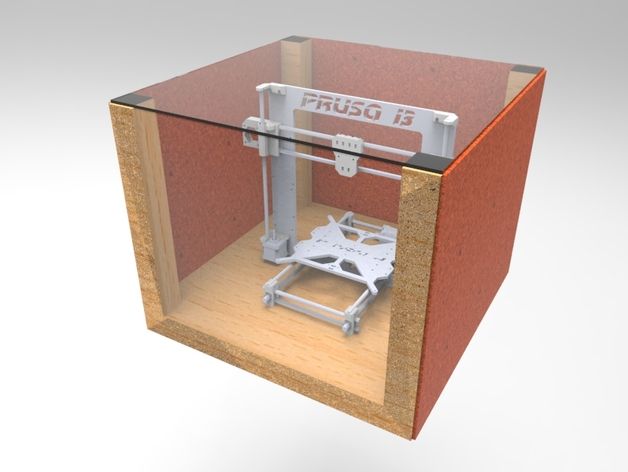 You can easily buy a reliable enclosed 3D printer for under $400. Naturally, if you have the budget, new professional-grade printers priced in the thousands of dollars hit store shelves each year, too.
You can easily buy a reliable enclosed 3D printer for under $400. Naturally, if you have the budget, new professional-grade printers priced in the thousands of dollars hit store shelves each year, too.
Advantages of Enclosed 3D Printers
✅
Better ABS and Nylon 3D printingEnclosures can cool parts down more slowly, and maintain more consistent and high heats within the build chamber. This reduces warping and splitting during the printing process.
✅
Much safer3D printer enclosures keep hot parts like the nozzle and heated bed away from kids if you have family at home, or if 3D printing at schools.
✅
QuieterThe enclosed area keeps noise in, making them ideal quiet 3D printers. Enclosures contain the whirring and buzzing of the printing process, a genuine boon if you’re printing at home or in a confined space with bad acoustics likely to amplify noise levels.
✅
Sturdier and more reliableEnclosed 3D printers are typically built with a sturdy cuboid structure, with four walls that prevent vibrations and other factors from worsening print quality.
✅ Noise Reduction
enclosures help keep noise levels down by containing the whirring and buzzing of the printing process, a genuine boon if you’re printing at home or in a confined space with bad acoustics likely to amplify noise levels.
Disadvantages of Enclosed 3D Printers
More expensive – 3D printers with enclosures cost more than open FDM printers. The logic is evident here; manufacturers have to spend more on raw materials and the assembly process, costs that invariably trickle down to consumers.
Difficult maintenance and troubleshooting – Due to the enclosed design, maintenance is much harder on an enclosed 3D printer. Cleaning, replacing, troubleshooting, or upgrading parts is far more troublesome than an open-design 3D printer.
FAQs
What Does a 3D Printer Enclosure Do?Enclosures help enhance printing performance by keeping hot air in and cold air/drafts out. For heat-sensitive materials like ABS, a stable higher temperature environment is crucial for proper layer adhesion and to reduce the chances of warping, curling, and other issues.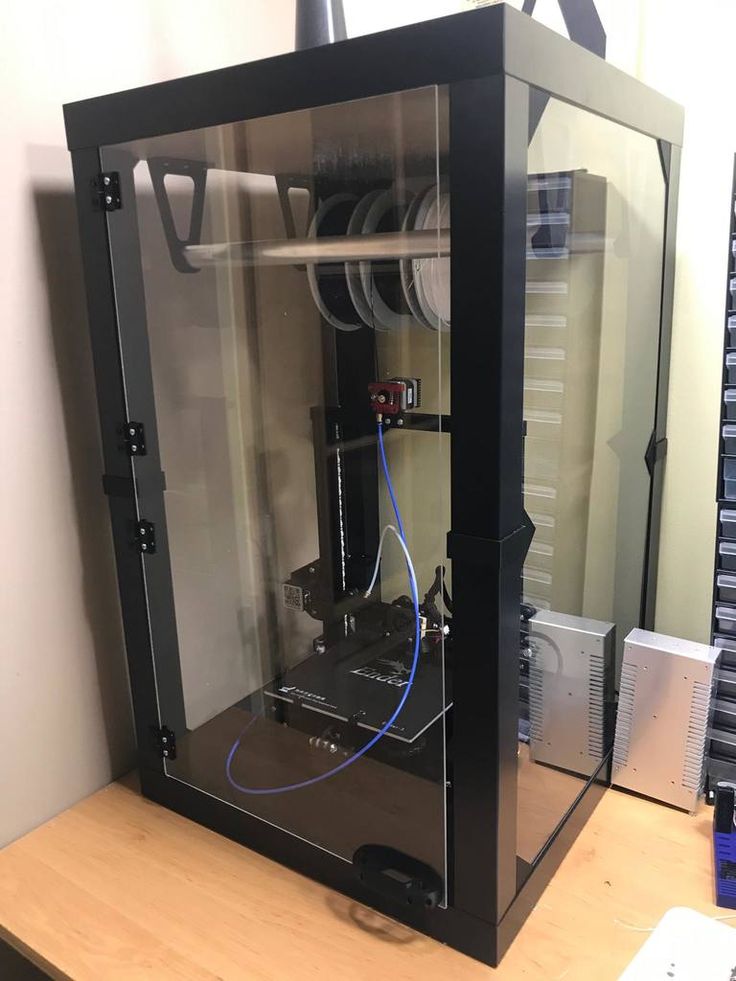 Similarly, an enclosure helps keep dust and dirt away from the printer’s parts and the print itself; essential for successful printing as impurities can affect adhesion and print quality.
Similarly, an enclosure helps keep dust and dirt away from the printer’s parts and the print itself; essential for successful printing as impurities can affect adhesion and print quality.
Yes. An enclosure keeps hot and moving parts away from curious fingers and hands, lessening the likelihood of injury compared to open-design printers where all the parts are exposed and readily accessible. If you live with children or work in an educational setting alongside younger students, an enclosed 3D printer provides peace of mind. Additionally, the filters often mounted in enclosed printers rid fumes of toxic elements.
How to Maintain an Enclosed 3D Printer?Enclosed 3D printer maintenance is identical to what’s involved in keeping an open-design printer in tip-top shape: regular cleaning of the bed and nozzle, firmware updates, routine inspection of parts for wear and tear, and bed leveling/calibration at regular intervals.
If you’re looking to print with ABS, yes. An enclosure provides the right, sustained ambient temperature for ABS to thrive. On the other hand, if you plan to print with PLA, an open-design printer stands as a better option. PLA requires plenty of cool air and ventilation to flourish.
Best 3D Printers of 2022 | Rating of TOP models of 3D printers for printing
Contents [Show]
The modern market of additive equipment offers many options for 3D printing equipment designed to solve various problems. Devices are in demand in engineering and design, architecture, medicine, industry, education, entertainment, engineering and many other areas. nine0003
Let's talk about what you should pay attention to when choosing a 3D printer, and also consider the rating of the best equipment models for amateurs and professionals in 2022.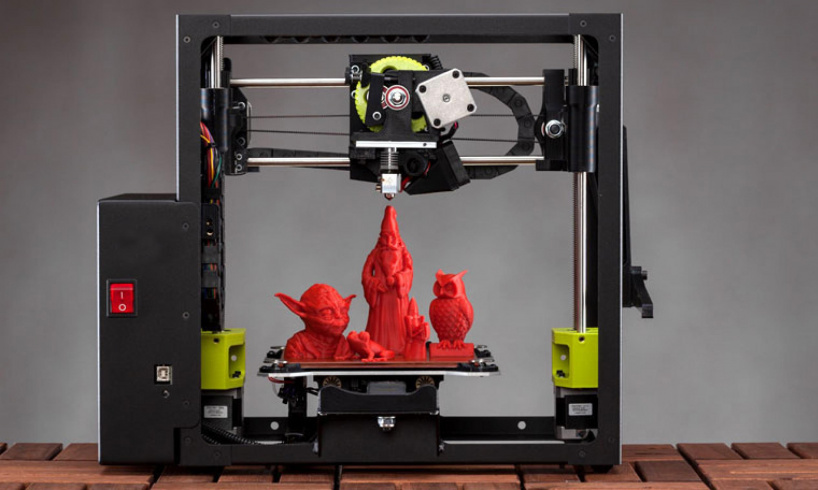
How to choose the right 3D printer
There are a number of basic parameters that you need to pay attention to when choosing a printer for bulk printing. Let's briefly consider each of them.
Printer type
According to the ISO / ASTM 52900: 2021 standard, approved by the International Organization for Standardization, 3D printers are divided into several categories depending on the characteristics of the printing process (for convenience, we will duplicate the trade names for each category): nine0003
- DED (SLS, MJF) - deposition and melting of material using a directed electron or laser beam.
- BJT (CJP, NPJT) - selective jet application of a binder composition to the powder for its sintering.
- MJT (MJP) - layer-by-layer inkjet application of photopolymer resin.
- MEX (FDM, FFF, PJP) - layer-by-layer application of the consumable through a heated nozzle (extrusion).
- VPP (SLA, DLP, LCD, CDLP) - photopolymerization, selective curing of a liquid photopolymer in a bath under the influence of a light source.
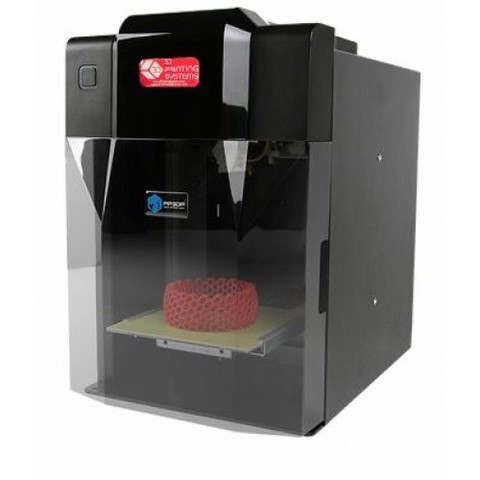 nine0018
nine0018 - SHL (LOM, Composite Lamination) - gluing (lamination) of sheets of material.
- PBF (SLM, DMLS, EBM) - fusion of certain areas of the powder layer under the influence of thermal energy.
Approval
This parameter largely depends on the printing technology and is standardly described in the vertical and horizontal planes (Z and XY, respectively).
The Z resolution is the height/thickness of the layer. The thinner the layer, the more accurate and detailed the model will be. XY resolution is the smallest possible movement of the print head, which cannot be less than the diameter of the nozzle or laser beam. nine0003
The highest resolution is provided by photopolymer 3D printers.
Compatible materials
The choice of consumable depends on the 3D printing technology used. FDM printers use special thermoplastics in the form of filaments (PLA, HIPS, ABS, PET, PETG, Wood, Flex, etc.), while photopolymer printers use various light-sensitive liquid resins.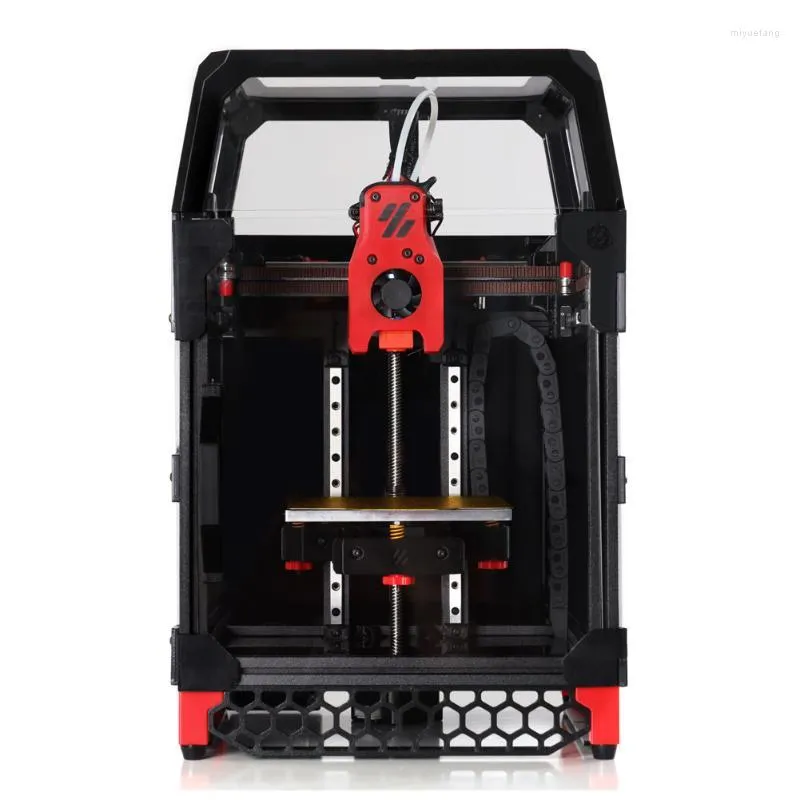 Sintering technology devices are designed to use engineering thermoplastics or metals in powder form. nine0003
Sintering technology devices are designed to use engineering thermoplastics or metals in powder form. nine0003
Many professional printers work with special purpose materials - composites (glass-filled materials, carbon fiber, etc.), metals, wood, concrete, ceramics, dental photopolymers, wax, etc.
Print platform (desktop, build platform)
This is the plate on which objects are printed. A high-quality platform ensures reliable adhesion of models to the surface (adhesion) during printing and at the same time makes it easy to separate them at the end of the process. nine0003
Typically, the print bed is made of glass, but other materials can also be used. To improve the contact of the material with the platform, special sprays and adhesives increase adhesion (Adhesion). Professional models of 3D printers usually have features that increase the resistance of printing to failures:
- flexible, removable or magnetic platform;
- automatic print area alignment system;
- heated platform for handling high temperature materials.
 nine0018
nine0018
Security
3D printing can be associated with some risks even when all safety regulations are followed. For example, high-temperature printing increases the risk of burns, and some powder materials or photopolymer resins are harmful to the skin.
To reduce the risk of exposure to toxic substances, some printers recommend the use of protective chambers, air filtration and ventilation systems, protective gloves, and goggles. There are also models of 3D printers designed to be serviced exclusively by trained personnel. nine0003
Noise level and motor drivers
Drivers and stepper motors directly affect the noise level during equipment operation. More advanced and expensive drivers, coupled with high-quality stepper motors, contribute to a significant reduction in the noise level during the printing process.
Self assembly
Most manufacturers offer additive devices that are ready to go. But some models of 3D printers are presented as self-assembly kits (DIY kits).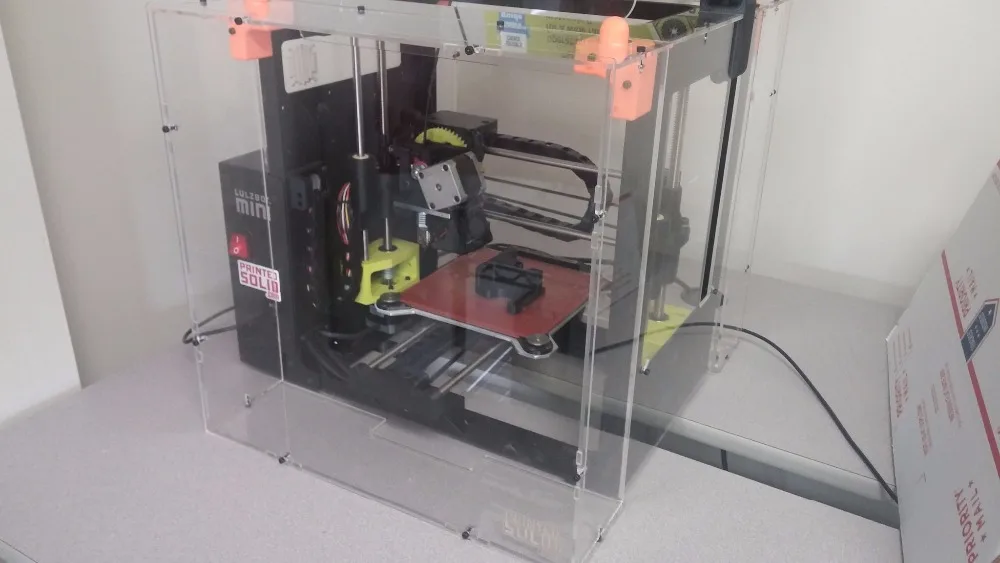 When buying, you need to consider that assembling such a device can cause certain difficulties, especially for the first time. nine0003
When buying, you need to consider that assembling such a device can cause certain difficulties, especially for the first time. nine0003
Product size
The choice of the area of the working area of the equipment depends on the dimensions of the parts that are planned to be printed on a 3D printer. For a home, it is enough to purchase a device with parameters up to 200x250x200 (WxHxD). This is enough to solve most problems. For more serious tasks, we recommend considering models with a working area of at least 306x306x610 (WxHxD), such a print volume will allow you to print large objects without subsequent gluing with the same print quality and resolution. nine0003
Technology
Let's take a closer look at the main technologies used in the field of 3D printing:
- FDM is a method of layer-by-layer deposition of plastic filament threads. Ideal for creating functional prototypes and parts from high-strength industrial plastics.
- DLP - layer-by-layer curing of photopolymer resins using LED projectors.
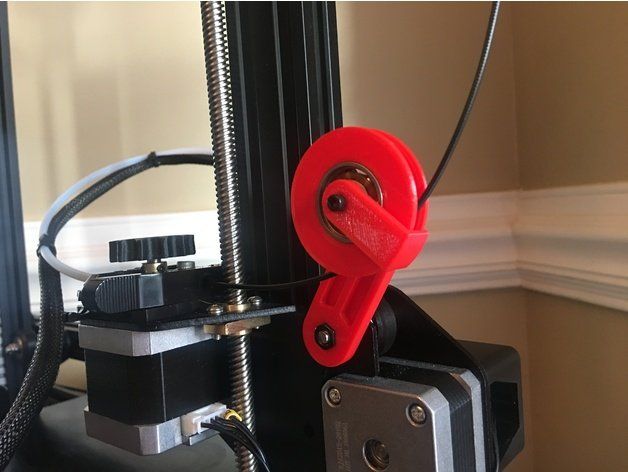 Allows you to produce ultra-precise, highly detailed objects with a high-quality surface. nine0018
Allows you to produce ultra-precise, highly detailed objects with a high-quality surface. nine0018 - SLA - curing layers of liquid photopolymer using a laser beam. Suitable for printing very precise products with complex geometry and fine details.
Multicolour printing
There are modifications of printers that support the function of printing in two or more colors. Most of these FDM devices are equipped with two presses filled with threads of different colors. A separate file is used to print each color, and sections of different colors are combined with each other like a three-dimensional puzzle. There are also color powder printing technologies, such as CJP or MJM, but the range of their application is limited to simple layout or prototyping. nine0003
Print surface
The surface quality of finished models depends on both the technology used and the print resolution. If necessary, the products are easily amenable to post-processing.
Housing type
Volumetric printers are available in an open or closed case.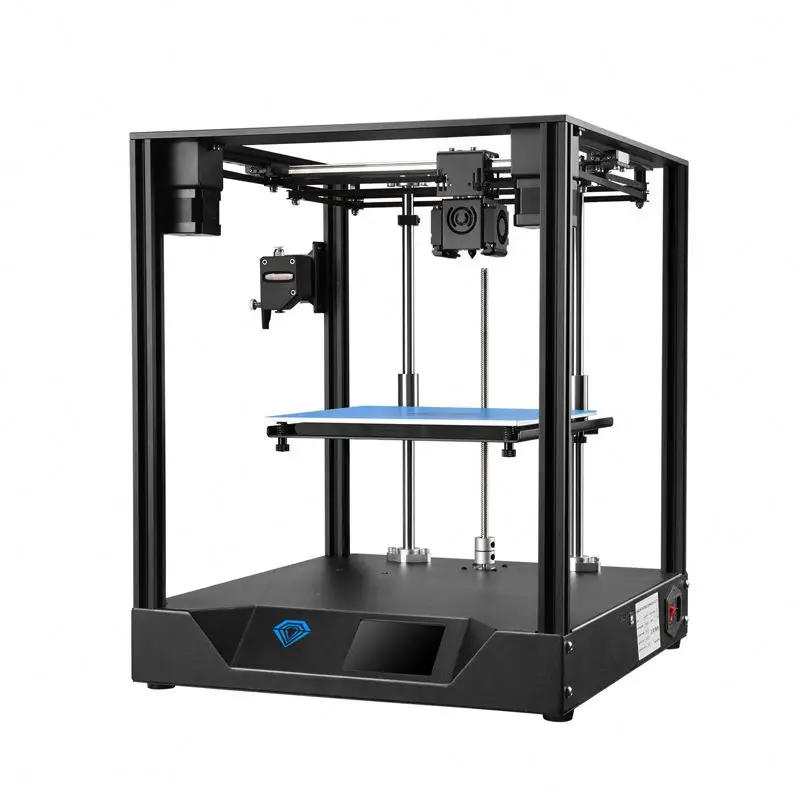 Open type devices are cheaper, but may have print quality issues and shrinkage of ABS products due to temperature differences. Enclosed printers have a more rigid, stable design and deliver high quality builds because their print surface is protected from dust and other unwanted particles. In addition, they have a low noise level and are safer to operate. nine0003
Open type devices are cheaper, but may have print quality issues and shrinkage of ABS products due to temperature differences. Enclosed printers have a more rigid, stable design and deliver high quality builds because their print surface is protected from dust and other unwanted particles. In addition, they have a low noise level and are safer to operate. nine0003
Connection
The majority of modern 3D printers have built-in memory, a port for USB flash drives or are equipped with SD memory cards, which allows you to continue the 3D printing process without a permanent connection to a PC. Some devices may also support wireless technology (Wi-Fi or P2P) or connect via Ethernet. Recently, more and more manufacturers include in their devices the possibility of forming 3D printing farms from a cluster of devices connected by one local network. nine0003
Software
Additive technology comes with special software or is compatible with open-source programs that can be downloaded, for example, from the manufacturer's website. As a rule, the software runs on Windows, Linux or MacOS. The software package may include modules for optimizing 3D models, building automatic supports (supports), controlling the movement of the printing block and desktop, and advanced preparation of layers for printing. nine0003
As a rule, the software runs on Windows, Linux or MacOS. The software package may include modules for optimizing 3D models, building automatic supports (supports), controlling the movement of the printing block and desktop, and advanced preparation of layers for printing. nine0003
3D printer models
Consider the different models of amateur and professional 3D printers recognized as the best in 2022.
Assembly kits
Self-assembly kits (DIY) are the most budgetary and popular variant of FDM/FFF/PJP 3D printers in Russia. The use of such kits allows you to independently assemble, configure, reconfigure and upgrade printing devices to suit your needs.
The most popular DIY kits in 2022: nine0003
Creality Ender 3
Thoughtfully designed home 3D printer with open chamber, large build area (WxHxD: 220x250x220mm) and high print quality at speeds up to 180mm/s. Works great with PLA, ABS, PETG, TPU, Wood and other plastics. Equipped with a single extruder, a heated worktable, a compact display that shows the main parameters, and an active cooling system. Suitable for printing small functional items, prototypes or decorative figurines. Connects via USB or microSD. nine0003
Suitable for printing small functional items, prototypes or decorative figurines. Connects via USB or microSD. nine0003
Flying Bear Ghost 5
Equipment for semi-professional use, equipped with an open chamber with dimensions of 255x210x210 mm. Due to the uniform supply of the filament, it allows you to produce high-resolution parts at a speed of up to 150 mm / s and an accuracy of up to 0.01 mm. The model is equipped with one extruder, a heated table, options for adjusting speed and temperature, an active cooling system and a convenient TFT color display. Compatible with HIPS, ABS, Wood, PLA, etc. Reliable, quiet operation. Connects via Usb, SD, Wi-Fi. nine0003
Creality Ender 5 Plus
A printer with a large working area (350x350x400 mm), one extruder and a filament sensor that prevents printing errors due to tangles or broken threads. It has a magnetic platform with heating up to 100 degrees in 10 minutes, a rigid, reinforced cubic frame and a reliable power supply with overheat protection. Provides fast, high-precision, stable printing with an adjustable layer thickness of 0.1-0.4mm.
Provides fast, high-precision, stable printing with an adjustable layer thickness of 0.1-0.4mm.
Creality Ender 6
Equipment with a closed plastic case, one extruder with a heating temperature of up to 260 degrees, a color touch screen and a build area of 250x250x400 mm. Ideal for small batch production and prototyping. The printer is equipped with a heated bed, connects via SD and is compatible with most of the available filaments. The layer height is 0.1-0.4 mm.
Budget 3D printers
This category includes inexpensive, ready-to-use FDM/FFF 3D printers designed for beginners - ordinary users, students in robotics circles, schools, etc. The devices are endowed with additional options that allow you to achieve excellent results with simple, understandable operation. nine0003
The best budget models of 2022:
Anycubic Mega S
Functional equipment with a working space of 210x210x205 mm and the possibility of resuming the work process after a power outage. The device has a color touchscreen, a heated platform with Ultrabase coating, connects via data cable or SD and prints at speeds up to 100 mm/sec. Layer height - 0.05-0.3 mm.
The device has a color touchscreen, a heated platform with Ultrabase coating, connects via data cable or SD and prints at speeds up to 100 mm/sec. Layer height - 0.05-0.3 mm.
FlashForge Adventurer 4
A good option for children or teenagers who are fond of 3D modeling. The printer has a working area of 200x200x250 mm, a heated platform, a color touch screen and is connected via USB, Ethernet or Wi-Fi. Construction speed - up to 150 mm / sec. Layer thickness - 0.1-0.4 mm. The model is also equipped with a built-in webcam, a filament end sensor, an auto-calibration function and the possibility of remote control through the application.
Voxelab Aries STEM
A printer with a full range of modern functions, designed to create objects of standard sizes (200x200x200 mm). Prints at speeds up to 80 mm/sec. and a layer thickness of 0.1-0.4 mm. Connection - Usb, SD, Wi-Fi. nine0003
QIDI i-Mate S
A device with a working space of 260x200x200 mm, connected via Usb, LAN or Wi-Fi.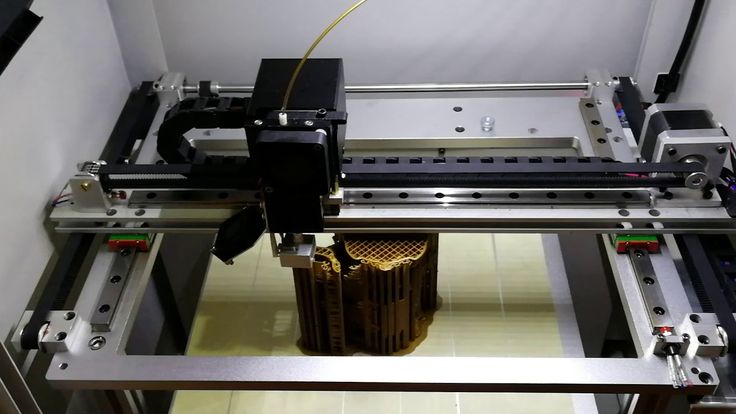 Layer thickness - 0.05-0.2 mm, construction speed - up to 80 mm/sec. Great for prototyping simple objects.
Layer thickness - 0.05-0.2 mm, construction speed - up to 80 mm/sec. Great for prototyping simple objects.
Budget Large Format 3D Printers
Devices designed to create a large number of small products in one go or to print large objects. These printers are equipped with a capacious platform and have increased reliability and stability. nine0003
The most popular low-cost large-format FDM 3D printers in 2022:
Wanhao D12/500
A model with an improved component base and mechanics, updated electronics, a redesigned feed mechanism, a heated platform and two extruders. Construction area - 500x500x500 mm. Layer thickness - 0.1-0.4 mm, build speed - up to 150 mm/sec. Connection - Wi-Fi, MicroSD.
Creality Ender 5 Plus
Apparatus with dimensions of the working area 350x350x400 mm. It has a robust construction with a reinforced structural profile frame and a heated platform. Provides the most accurate, stable printing and smooth, stable movement along the axes.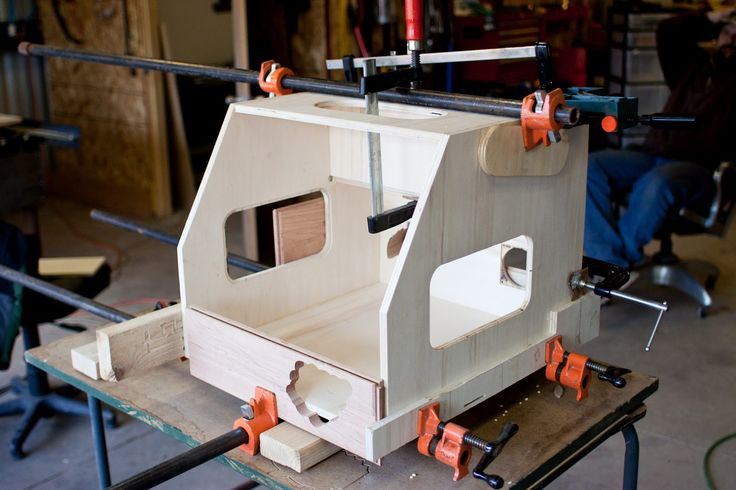 Connected via SD. The layer height is 0.1-0.4 mm.
Connected via SD. The layer height is 0.1-0.4 mm.
Creality CR-10S Pro V2
A 3D printer that delivers high performance and exceptional print stability. Ideal for creating print trusses that produce large runs of the same type of parts. Construction volume - 300x300x400 mm. Print speed - up to 180 mm / sec. (recommended speed is up to 60 mm/s). Layer height - 0.1-0.4 mm. Connection - SD. nine0003
Professional 3D printers
Professional-grade printers are designed to produce complex objects using high-temperature engineering plastics and other consumables. Such equipment has a closed chamber to maintain a certain temperature and ensure stable printing.
Best Professional FDM 3D Printers of 2022:
FlashForge Creator Pro 2
Technique with two independent extruders for simultaneous printing of two identical products. The second extruder can be used to create soluble supports for the production of complex models with a quality surface. Construction area - 200x148x150 mm. Layer height - 0.1-0.4 mm, build speed - up to 100 mm/sec. Connection - Usb, SD.
Construction area - 200x148x150 mm. Layer height - 0.1-0.4 mm, build speed - up to 100 mm/sec. Connection - Usb, SD.
Picaso Designer Classic
A printer designed to solve a wide range of tasks. It has built-in profiles for different types of plastic, which makes it easy to start printing. Chamber size - 200x200x210 mm. Work speed - up to 100 cm3 / h, layer thickness - from 0.01 mm. Connection - Usb, Ethernet. nine0003
Anycubic 4Max Pro 2.0
Advantages of the model: dual drive extruder for working with soft, flexible plastics, filament end sensor, silent drivers, color display. The device provides the most accurate, stable printing at speeds up to 150 mm/sec. Camera dimensions - 270x210x190 mm. Layer thickness - 0.05-0.3 mm. Types of connection - Usb, SD.
QIDI Tech X-Plus
A printer with a capacious working chamber (270x200x200 mm), one extruder with a heating temperature of up to 300 degrees and a build speed of up to 150 mm/sec.![]() Equipped with a heated platform, connects via Wi-Fi, Usb or LAN, the layer height is 0.05-0.2mm. nine0003
Equipped with a heated platform, connects via Wi-Fi, Usb or LAN, the layer height is 0.05-0.2mm. nine0003
Professional single extruder 3D printers
Additive equipment of this kind is designed to solve various problems, from relatively simple to complex.
The most popular models of professional FDM/FFF 3D printers with one print head:
Picaso Designer X S2 (Series 2)
The main difference of this modification is the heating of the extruder up to 430 degrees, which allows working with a wide range of plastics, including engineering ones (ABS, PETG, PLA, PEEK, Nylon, Flex, etc.). Dimensions of the working chamber - 201x201x210 mm. Connection - Usb, Ethernet. Speed - up to 150 mm / s. Layer thickness - from 10-250 microns. The printer is equipped with a heated bed. nine0003
QIDI X-Max
A 3D printer with a large printable area (300x250x300 mm) and a wide range of useful features. It has a robust design with a strong double Z-rail, a heated platform with a double-sided coating for working with different types of plastic and a 5-inch touch screen.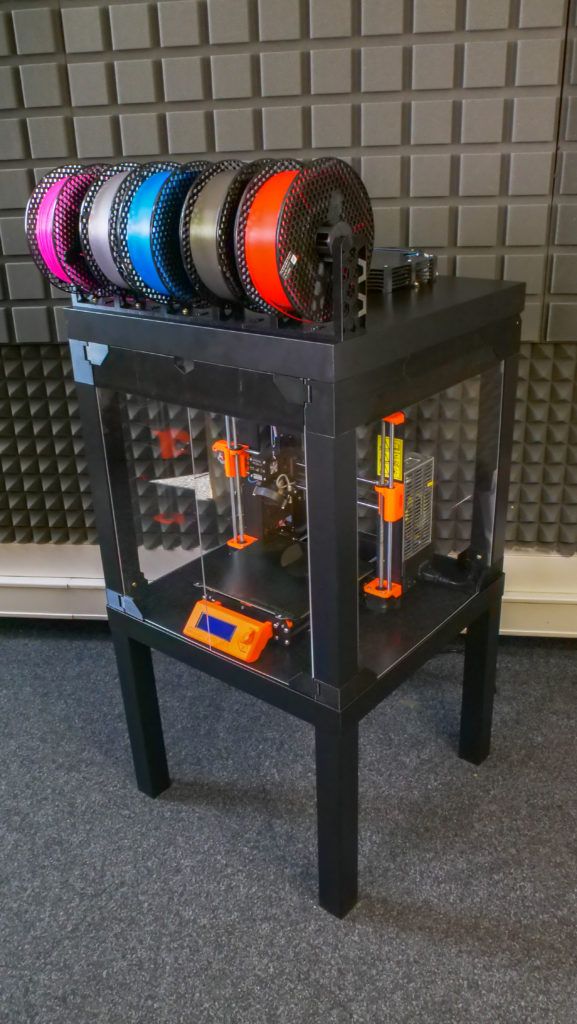 The extruder heats up to 300 degrees. Compatible filaments - PLA, ABS, PETG, PC, Carbon, Nylon, Flex, etc. Connection type - USB storage, LAN, Wi-Fi. Working speed – up to 150 mm/sec. Layer height - 0.05-0.2 mm. nine0003
The extruder heats up to 300 degrees. Compatible filaments - PLA, ABS, PETG, PC, Carbon, Nylon, Flex, etc. Connection type - USB storage, LAN, Wi-Fi. Working speed – up to 150 mm/sec. Layer height - 0.05-0.2 mm. nine0003
Picaso Designer XL S2
The model is designed for printing with engineering and refractory materials, as the print head heats up to 430 degrees. Robust aluminum body with steel frame guarantees reliability and no vibration during operation. Chamber size - 360x360x610 mm. Speed - up to 130 cm3 / h. Layer thickness - 10-250 microns. Connection type - USB-drive, Ethernet.
TierTime UP300
It is equipped with three separate extruders for working with different materials (low-temperature, high-temperature, standard), as well as various interchangeable platforms (smooth, perforated, glass). Supports print queue for different users. Dimensions of the working area - 205x255x225 mm, layer height - 0.05-0.4 mm. Connection - Usb, LAN, Wi-Fi.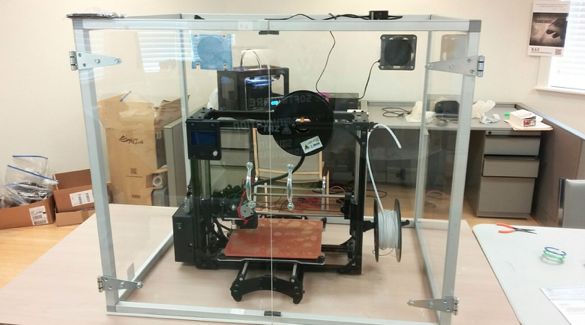
Bizon 3
An updated version of the Bizon 2 model. Layer thickness - 0.02 - 0.65 mm. Print area size: 300x300x400mm. Print speed: up to 160 mm/s. Layer height: from 0.02 to 0.65 mm. Connection type: USB, SD card. nine0003
Mid-range large format 3D printers
This category includes models for universities, specialized colleges and offices of medium-sized companies.
The best mid-range large format FDM 3D printers in 2022:
Raise3D Pro3 Plus
Equipment with a transparent body and two extruders equipped with a lifting mechanism, well-thought-out kinematics, interchangeable nozzles of different diameters and a convenient 7-inch color touch screen. Other options: Low Filament Sensor, Print Resume System, RaiseCloud Firmware, Webcam, IdeaMaker Slicer, RaiseCloud Cloud Service. Printed volume: 300x300x605 mm (for one extruder), 255x300x605 mm (for two extruders). Connection - Wi-Fi, Usb, LAN. Speed – up to 150 mm/sec.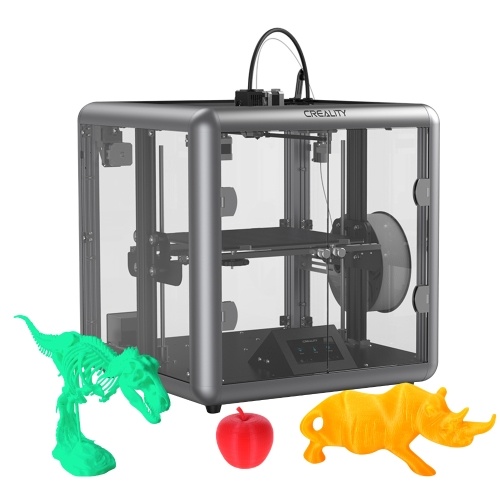 Layer thickness - from 0.01 mm. nine0003
Layer thickness - from 0.01 mm. nine0003
Flash Forge Creator 4
High-performance, accurate 3D printer with a system of two independent extruders and an advanced thermal management system inside the chamber (to protect against cracking and deformation of engineering plastics). Robust steel body prevents vibration. Print area - 400x350x500 mm. Speed – up to 200 mm/sec. Layer height - from 0.01 mm. Connection - Usb, Wi-Fi, LAN.
Picaso Designer XL Pro S2
Large-format model with a working area of 360x360x610 mm, a heated platform and two extruders with a heating temperature of up to 430 degrees. The device has a simple automatic calibration, a built-in material spool drying mode and a plastic feed control system. Layer thickness - 0.01 mm, speed - up to 130 cm3/h. Connection type - Usb, Ethernet.
CreatBot D600 Pro
The printer with the largest print area is 600x600x600 mm. Equipped with two extruders with heating up to 260 and 420 degrees respectively (for working with standard or engineering plastics).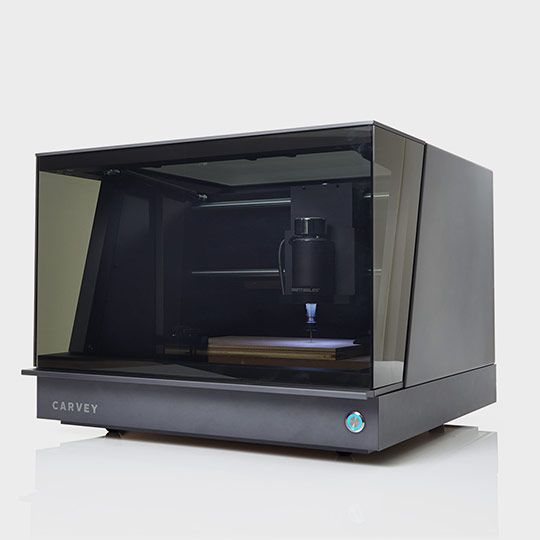 Other features: heated chamber, platform and compartments, speed - up to 120 mm/s, layer thickness - from 0.05 mm. Connection type - Usb. nine0003
Other features: heated chamber, platform and compartments, speed - up to 120 mm/s, layer thickness - from 0.05 mm. Connection type - Usb. nine0003
Professional Dual Extruder 3D Printers
Professional FDM printers with two extruders are designed to solve the most complex tasks. This technique is equipped with a fully functional slicer and a reliable nozzle lift mechanism or independent extruders.
The most popular professional grade dual extruder 3D printers:
Raise3D Pro2 Plus
The flagship model of the manufacturer, endowed with a full range of useful features. The equipment, enclosed in a transparent case, is connected via Usb, Wi-Fi or LAN and is distinguished by quiet operation. Equipped with an extruder lifting mechanism, a 7-inch color touch screen, a filament end sensor, and a print resume system. Includes RaiseCloud software, webcam, replacement nozzles. Print volume - 305x305x605 mm (for 1 extruder), 280x305x605 mm (for 2 extruders).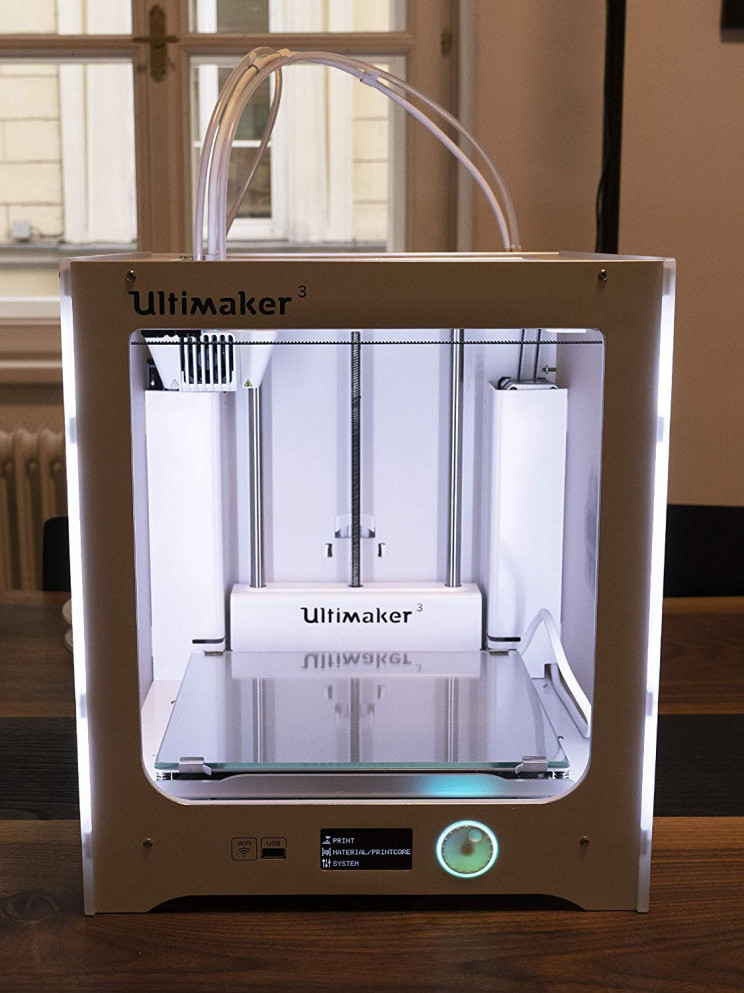 Speed – up to 150 mm/sec. Layer height - from 0.01 mm. Connection - Usb, Wi-Fi, LAN. nine0003
Speed – up to 150 mm/sec. Layer height - from 0.01 mm. Connection - Usb, Wi-Fi, LAN. nine0003
Picaso Designer X Pro S2
A compact device with dimensions of the construction area of 201x201x210 mm, providing excellent print quality. It has a high temperature mode with heating up to 430 degrees for printing with complex filaments. Speed - up to 130 cm3 / h, layer thickness - from 0.01 mm. Connection - Usb, Ethernet.
Raise3D E2
High-performance 3D printer with two independent print heads (IDEX system), heated platform and print speed up to 150 mm/sec. A built-in step-by-step video instruction for site calibration is provided. Layer thickness - 0.02-0.25 mm. Connection - Usb port, Wi-Fi, LAN. Print volume - 330x240x240 mm (1 printhead), 295x240x240 mm (2 extruders).
FlashForge Creator 3 Pro
Model with a large chamber (300x250x200 mm), HEPA filter, built-in webcam, color screen and the ability to install hardened nozzles with a material melting point of up to 320 degrees.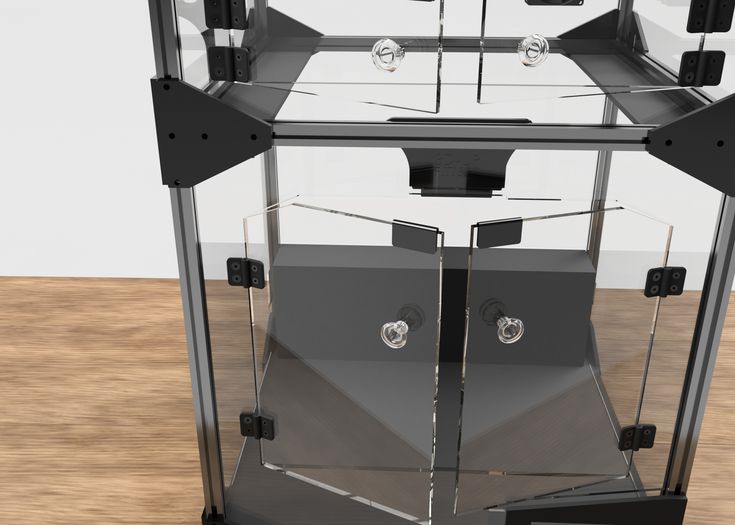 The heating speed of the working platform is up to 120 degrees in 3 minutes. Print speed - up to 150 mm / sec. Layer thickness - 0.05-0.4 mm. Connection type - Usb, Ethernet, Wi-Fi.
The heating speed of the working platform is up to 120 degrees in 3 minutes. Print speed - up to 150 mm / sec. Layer thickness - 0.05-0.4 mm. Connection type - Usb, Ethernet, Wi-Fi.
CreatBot F430 PEEK
3D printer ideal for PEEK and other filaments. Equipped with a closed chamber with temperature support and two printheads with heating up to 260 and 420 degrees, respectively. Construction area - 400x300x300 mm. Layer height - from 0.02 mm. Speed – up to 180 mm/sec. Connection - Usb.
Ultimaker S5
An easy-to-use device that prints with threads of non-standard diameter - 2.85 mm. The size of the working area is 330x240x300 mm. Layer thickness - from 0.02 mm. Speed - 24 mm3 / sec. Connection type - Usb, Ethernet, Wi-Fi. nine0003
Photopolymer desktop 3D printers
Modern models of 3D printing devices using photopolymers are equipped with monochrome displays with a resolution of up to 8K, which provide high speed and quality of building objects of any geometry.
Best photopolymer 3D printers of 2022:
Phrozen Sonic Mini 8K
A compact budget LCD printer with over 2000 hours of uninterrupted operation. Equipped with 8K 7.1” Mono LCD display. Print volume - 165x72x180 mm. Layer height - 0.01-0.3 mm. Resolution along the XY axis - 22 microns. nine0003
Phrozen Sonic 4K 2022
Equipment for permanent loads, ideal for dental laboratories and dental clinics. It has a heated chamber 134x75x200 mm with an odor filter and a Mono 4K 6.1” LCD display. Layer thickness - 0.01-0.3 mm.
Formlabs Form 3+
LFS printer with an intuitive interface and many special settings. The light source is a 250 mW laser. The size of the working area is 145x145x185 mm. Layer thickness - 0.025-0.3 mm. nine0003
Anycubic Mono X 6K
3D printer with a working chamber 197x122x245 mm and a high-quality Mono 6K 9.25” LCD screen. Layer height - 0.01-0.15 mm.
XYZ Part Pro 150
Equipped with a 5 inch LCD touch screen. Illumination source: 405 nm UV laser. Print area size: 150x150x200 mm. Layer thickness: 25 to 200 microns (0.025 - 0.2 mm).
Illumination source: 405 nm UV laser. Print area size: 150x150x200 mm. Layer thickness: 25 to 200 microns (0.025 - 0.2 mm).
Best Large Format Desktop Resin 3D Printers
Phrozen Sonic Mega 8K
The best 3D printer in its segment, capable of solving tasks that usually only an entire farm can handle. Suitable for both mass production of small detailed products, and for printing huge objects and dioramas. It is equipped with a 15-inch Mono 8K LCD display and has a working area of 330x185x400 mm. Resolution - less than 50 microns, layer height - 0.01-0.3 mm.
Formlabs Form 3L
nine0003
LFS-technique with a construction area of 335x200x300 mm, creating high-precision details using a 2x250 mW laser with a spot diameter of 85 microns. It is possible to install two cartridges at the same time for uninterrupted printing of large models. Layer thickness - from 0.025 mm.
Totals
All 3D printers reviewed have been rigorously tested in practice and tested by experienced engineers. Each of them has its own advantages and disadvantages, therefore, when choosing a model, it is necessary to focus, first of all, on the expected result, equipment functionality and budget. nine0003
Each of them has its own advantages and disadvantages, therefore, when choosing a model, it is necessary to focus, first of all, on the expected result, equipment functionality and budget. nine0003
If you find it difficult to make a choice, please contact 3DTool. Our experts will help you choose the right 3D equipment and consumables for you.
8 Best Enclosed 3D Printers of 2022 (All Price Ranges)
Enclosed 3D printers prevent cold air from entering the print, causing warping or other problems. For basic materials like PLA, 3D printer cases don't matter much, but for more complex materials like ABS and Nylon, they will save you time and time again. nine0003
Most cheap 3D printers are open 3D printers - they don't have a frame or casing (sometimes you can buy them separately) and print outdoors. Almost all 3D printer kits like the Ender 3 and CR-10 are open source 3D printers.
However, this may cause problems. ABS, a widely used material for 3D printers, warps if it is not cooled slowly. In addition, closed 3D printers allow you to keep hot and dangerous parts of the 3D printer away from your hands and others. This is especially important for kids, which is why indoor 3D printers are some of the best 3D printers for kids. nine0003
In addition, closed 3D printers allow you to keep hot and dangerous parts of the 3D printer away from your hands and others. This is especially important for kids, which is why indoor 3D printers are some of the best 3D printers for kids. nine0003
Contents
- Best indoor 3D printers under a thousand dollars
- Flashforge Adventurer 3 Lite - cheapest indoor 3D printer
- Monoprice Voxel - budget indoor 3D printer
- QIDI Tech X-Pro excellent 3D printer - with case for 0
- Flashforge Creator Pro 2 - best low cost IDEX printer
- BIBO 2
- Best closed consumer 3D printers
- Dremel 3D45
- Raise3D E2
- Top of the line 3D printers in the upper price range with housings
- Raise3D Pro2
- Ultimaker S5 (with housing kit)
- Buyer's Guide - What to look for
- Benefits of closed 3D printers
- Top closed questions 3D printers under a thousand dollars
- Price: around $339
- Assembly volume: 150 x 150 x 150 mm
- Closed chamber
- Reliable, beginner-friendly printer
- Wi-Fi connectivity
- Materials: PLA, ABS, Heavy Duty PLA, PLA Color Change, Metal Filled, Wood and High Speed PLA
- Price: $449
- Assembly volume: 150 x 150 x 150 mm
- Cheap Indoor 3D Printer
- Beginner Friendly
- WiFi Printing and Touchscreen on an Inexpensive Device
- Materials: ABS, PLA, PETG, Flexibles
- Price: $500
- Assembly volume: 230 x 150 x 150 mm
- Large 4.5" touchscreen for ergonomic printing
- Flexible assembly plate
- WiFi printing and dual extrusion for $500
- Materials: ABS, PLA and PETG
- Build volume: 200 x 148 x 150 mm
- Inexpensive independent system with two extruders
- Fully enclosed print chamber
- Materials: PLA, Pearl PLA, ABS, ABS Pro, PVA and HIPS
- Price: $679
- Assembly volume: 216 x 187 x 160 mm
- WiFi printing, dual extrusion and touchscreen, all for just over $500.
- Minimum layer height 50 microns
- Claims it can print polycarbonate but also says max temperature is 270C
- Materials: PLA, ABS, HIPS, flexible threads, PETG, nylon, PC, carbon fiber
- Best Indoor 3D Printers for Consumers
- Price: $1,599
- Assembly volume: 254 x 152 x 170 mm
- Powerful automatic leveling system
- Highly rated customer support
- Universal
- Materials: PLA, PETG, Eco-ABS, Nylon
- Price: $3,499
- Assembly volume: 330 x 240 x 240 mm
- Build volume is reduced to 295 x 240 x 240mm when using the dual extruder
- Useful "Mirror" and "Duplicate" modes
- Built-in security measures
- Materials: PLA, ABS, HIPS, PC, TPU and TPE, PETG, Nylon, PP, ASA, PVA, Glass Filament, Metal Filled, Carbon Fiber and Wood Filled.
- Price: $3,999 / $5,999
Build Volume: 305 x 305 x 300 (605) mm - Dual extruder build volume: 280 x 305 x 300 mm
- A complete printer: accurate, reliable, closed, versatile.
- Materials: PLA, ABS, HIPS, PC, TPU, nylon, ASA, PETG, PVA, glass, carbon fiber, wood.
- Price: $5,995
- Assembly volume: 330 x 240 x 300 mm
- Excellent accuracy and print quality
- Reliable and efficient in many materials
- Pro Bundle makes it even more efficient indoor 3D printer
- Materials: PLA, CPE, NYLON, ABS, glass, carbon fiber, PC, PVA, PP, TPU
Flashforge Adventurer 3 Lite is the cheapest indoor 3D printer
Flashforge Adventurer 3 Lite is a compact and quiet, fully enclosed beginner printer that provides friction-free printing.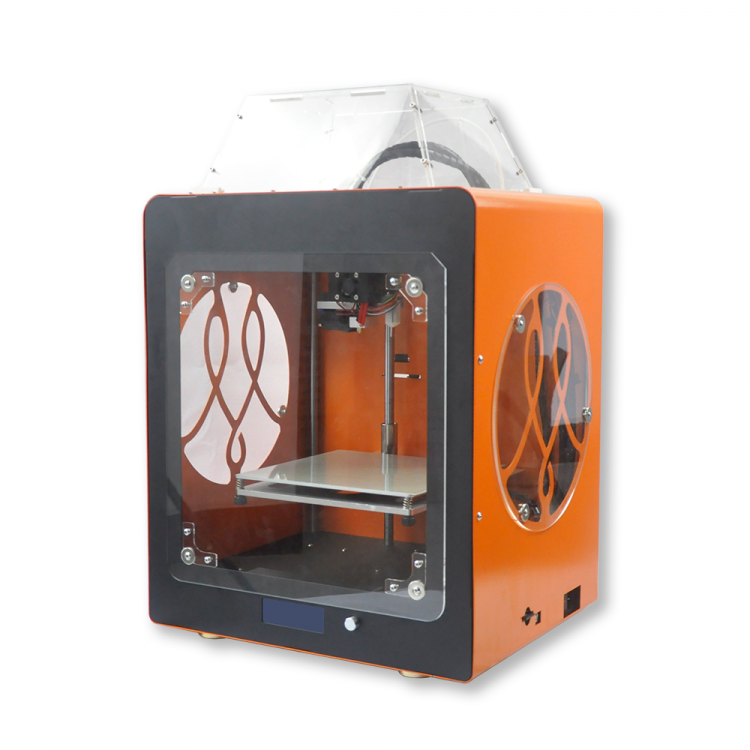 Printer setup is minimal other than a well-managed five-point calibration process, making it the best choice for beginners or students looking to start printing without the hassle.
Printer setup is minimal other than a well-managed five-point calibration process, making it the best choice for beginners or students looking to start printing without the hassle.
It is almost identical to the Adventurer 3, except for the built-in camera and thread runout sensor. These minor features do not detract from the simple typing experience. nine0003
In addition to a sleek, closed design, the Flashforge Adventurer 3 Lite has everything you need to handle tough materials like ABS: a flexible heated bed with a maximum temperature of 100°C and a maximum nozzle temperature of 240°C. With these features, you can also work with more exotic heat-sensitive materials such as metal, wood, and more.
It also features a wide range of connectivity options, including Wi-Fi and remote print monitoring thanks to FlashForge's 3D Cloud Print technology. The build volume of 150 x 150 x 150mm results in a narrow printable area, which is one of the few gripes I had when evaluating the Flashforge Adventurer 3 Lite. You won't have much luck printing bulky and tall parts, but this is easy to fix by printing in batches. nine0003
You won't have much luck printing bulky and tall parts, but this is easy to fix by printing in batches. nine0003
It is also worth noting that the filament compartment located on the side of the printer, although practical, is not intended for all types and brands of filament. You may need an external holder if your chosen third party filament is not suitable.
Highlights:
Monoprice Voxel - Budget Indoor 3D Printer
The cheapest indoor 3D printer we recommend, the Monoprice Voxel is one of the best 3D printers for beginners. It's very easy to set up (within 10 minutes!), easy to operate with a touch screen, can print over WiFi, and comes with 8GB of onboard storage for 3D printer files.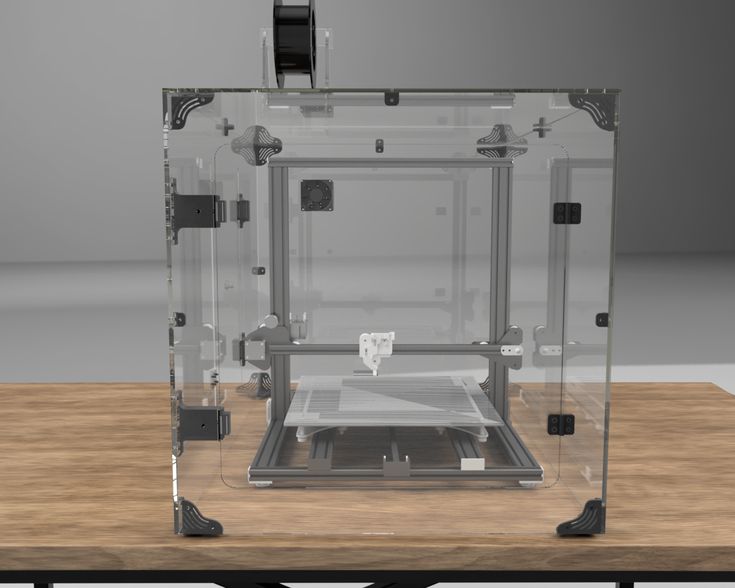 It comes with several 3D models in files, as well as some materials to get you started, so you can go from unboxing to printing in minutes. nine0003
It comes with several 3D models in files, as well as some materials to get you started, so you can go from unboxing to printing in minutes. nine0003
If you're new to 3D printing and aren't too tech-savvy, assisted leveling lets you reduce the experience to a simple click. It also comes fully assembled, so you won't need any DIY skills, which is surprising considering most printers in this price range are 3D printing kits. It can also connect to Polar Cloud, allowing you to manage and control your printer remotely, and even do so for multiple printers at the same time. nine0003
Key Points:
QIDI Tech X-Pro is a great 3D printer with a $500 case
One of last year's most popular low cost 3D printers, the Qidi Tech X-Pro offers reliability, precision, dual extrusion and an efficient closed area print, all for $500.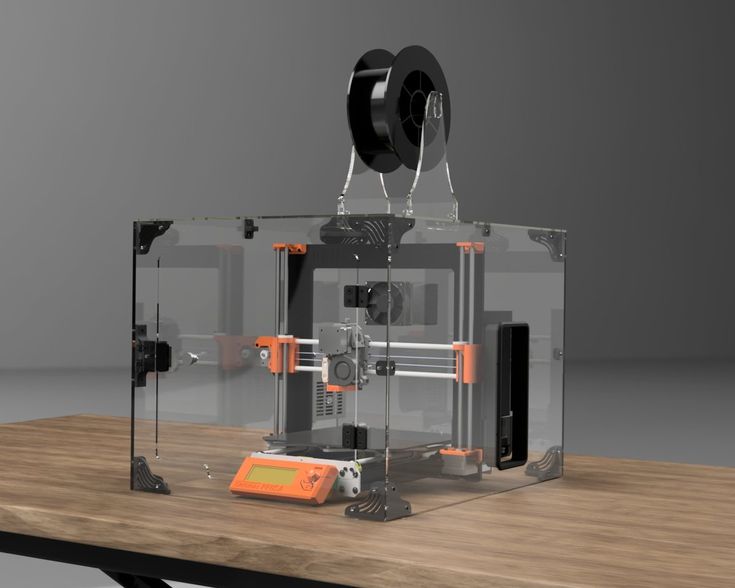 nine0003
nine0003
The layer thickness starts from 0.05 mm, the printer can print at speeds from 30 to 150 mm/s - although at such high speeds the print quality deteriorates noticeably. The printer is Mac and Windows compatible and can print over WiFi, USB or Ethernet.
Flexible, removable plate allows easy removal of prints with minimal damage, and comes with Qidi Tech's own QidiPrint 3D Slicer. Overall, this is one of the best indoor 3D printers under $500. nine0003
Highlights:
Flashforge Creator Pro 2 - Best value IDEX printer
A well-equipped update to the classic Creator Pro, the Flashforge Creator Pro 2 offers all the benefits of a case with features you don't expect to see in the $600-$700 range.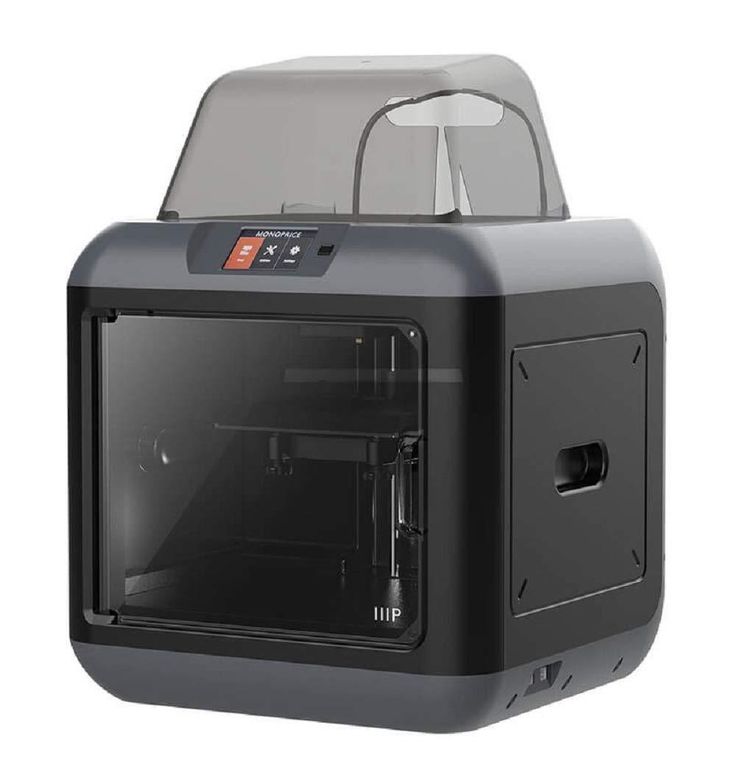 We see it as an ideal second printer for manufacturers who have already completed their initial training on a budget FDM kit and are now looking for something more versatile and feature rich. nine0003
We see it as an ideal second printer for manufacturers who have already completed their initial training on a budget FDM kit and are now looking for something more versatile and feature rich. nine0003
While the Flashforge Creator Pro 2 has a solid, well-made enclosed print chamber suitable for both ABS and PLA thanks to its removable acrylic top cover, it's the independent dual extruder system that sets it apart from other top enclosed 3D printers.
The IDEX system is almost unheard of at this price point, giving manufacturers the flexibility to work with specular prints, duplicate prints, dissolvable support structures, and even print multiple materials or colors at the same time. It is suitable for complex prints with vertical overhangs or is the perfect tool to help the teacher to release as many student-designed prints as quickly as possible. nine0003
These two centerpieces aside, Flashforge Creator Pro 2 completes the offering with a touch interface, 200 x 148 x 150mm volume and compatibility with PLA, Pearl PLA, ABS, ABS Pro, PVA and HIPS materials.
It's worth noting that Flashforge made the wrong choice by tying the Creator Pro 2 to its own FlashPrint slicer. It does its job well enough, but doesn't have the versatility of an open source software suite like Cura. This isn't necessarily the deciding factor, especially for those new to 3D printing or educators who want simple software and pre-loaded settings specifically tuned to work with the Creator Pro 2 right from the start. nine0003
Highlights:
BIBO 2
The Bibo 2 printer, with character and affordable for hobbyists, offers 50 micron precision, dual extrusion and WiFi printing, all for less than $1,000. nine0003
Although this closed 3D printer is not an IDEX printer, it still offers copy printing modes for printing two identical objects at the same time.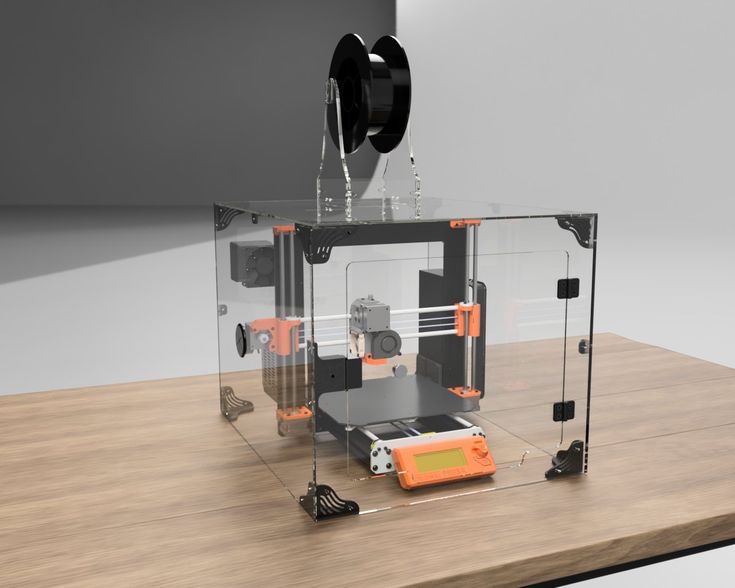 It features an easy-to-use touch screen - which isn't a given in this price range - and has a low-filament detection feature to avoid spoiling prints.
It features an easy-to-use touch screen - which isn't a given in this price range - and has a low-filament detection feature to avoid spoiling prints.
In addition to the ABS and Nylon efficient 3D printer housing, Bibo is built in a stable and durable aluminum frame, minimizing unwanted vibrations that can slightly affect print performance and quality. Overall, this is a great indoor 3D printer for the price, and it can also come with a laser engraver kit. nine0003
Highlights:
Best Indoor 3D Printers for Consumers
Dremel 3D45
Accurate, versatile and ideal for teaching 3D printing in schools, the Dremel 3D45 builds on nearly a century of Dremel manufacturing experience. Accuracy down to 50 microns, WiFi, USB or Ethernet cable connectivity, Mac and Windows compatibility, and iPad compatibility make the Dremel Digilab 3D45 the perfect addition to any school or business prototyping environment. nine0003
Accuracy down to 50 microns, WiFi, USB or Ethernet cable connectivity, Mac and Windows compatibility, and iPad compatibility make the Dremel Digilab 3D45 the perfect addition to any school or business prototyping environment. nine0003
The heated plate allows you to print on nylon and Eco-ABS, while the built-in HD camera provides convenient remote control of the print progress, which is easily done using cloud-based 3D printing software.
If you have any problems, Dremel's USA support team is here to help. Overall, this is a solid and accurate indoor 3D printer that offers good volume and results for the price.
Highlights:
Raise3D Large Enclosed 3D Printer adds to IDEX's already impressive range of dual extruder 3D printers. The extruders of IDEX 3D printers can move independently of each other, which greatly increases the speed and efficiency of printing, especially when printing multiple identical or identical parts. nine0003
The extruders of IDEX 3D printers can move independently of each other, which greatly increases the speed and efficiency of printing, especially when printing multiple identical or identical parts. nine0003
Raise3D E2
The E2 printer has two main modes:
Mirror mode: 3D printing simultaneously prints inverted mirror versions of your model, such as the sole of a shoe for the left and right foot.
Duplicating mode: uses both extruders synchronously, printing two identical objects at the same time and doubling the printing efficiency.
The E2 3D printer case keeps heat inside and everything else outside. If the door is opened during printing, the process is immediately suspended so that no one is burned or injured by the extruder or the heated layer. The E2 is also equipped with an efficient air filtration system that removes melted plastic particles and odors, as well as filament end sensors and power-off recovery functions.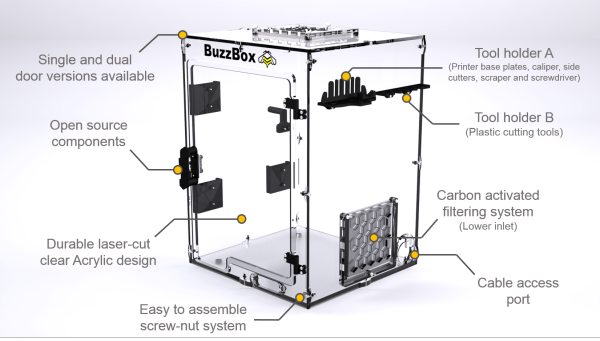 nine0003
nine0003
Highlights:
Top-of-the-range 3D printers with housings
Raise3D Pro2
A true workhorse full-body 3D printer, the Raise3D Pro2 series offers incredible precision, material compatibility, great workflow and many other key features.
The standard Pro2 already has a very large build area, while the Pro2 Plus extends the z-axis range to parts up to 605mm high. The extruders can reach temperatures of 300C for even the toughest materials such as PC, and the dual extruders enable efficient printing with support for soluble materials as well as multi-color 3D printing.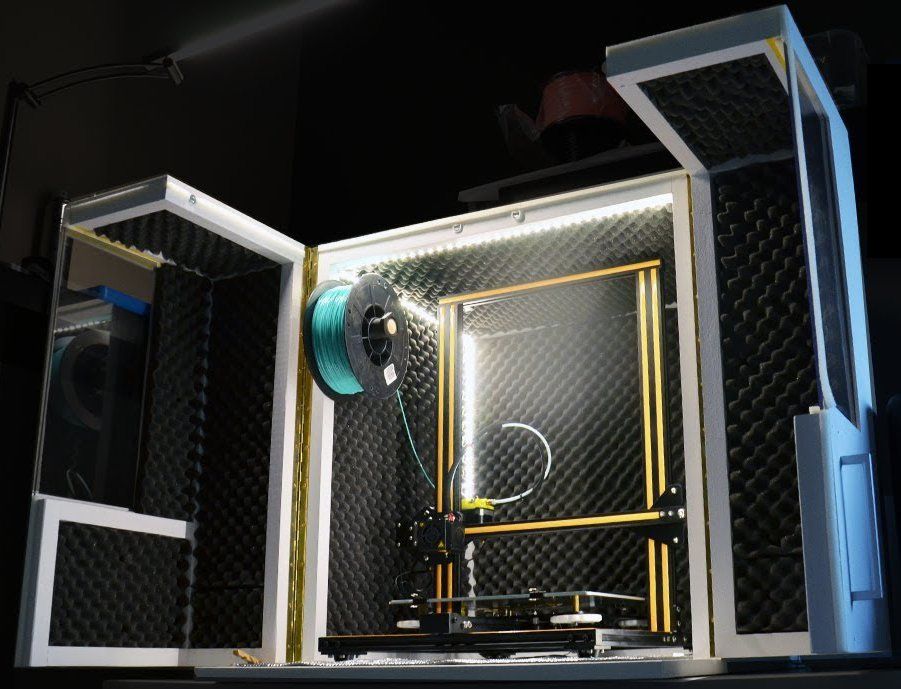 nine0003
nine0003
With a minimum layer height of 0.01mm, Pro2 3D printers can print incredibly sharp and finely detailed details. Swap out the nozzle for a smaller nozzle and focus on the small details to get a fantastic finish. The built-in camera makes it easy to control prints, while the 7-inch touch screen provides data and an easy-to-use overall workflow.
Highlights:
Ultimaker S5 (with housing kit)
The Ultimaker S5 is capable of printing industrial grade parts with layer resolution down to 20 microns. An enclosed 3D printer that becomes even more efficient and safer with the S5 Pro kit, the S5 delivers reliable and repeatable dual extrusion with amazing precision, even with abrasive filaments such as glass and carbon fiber.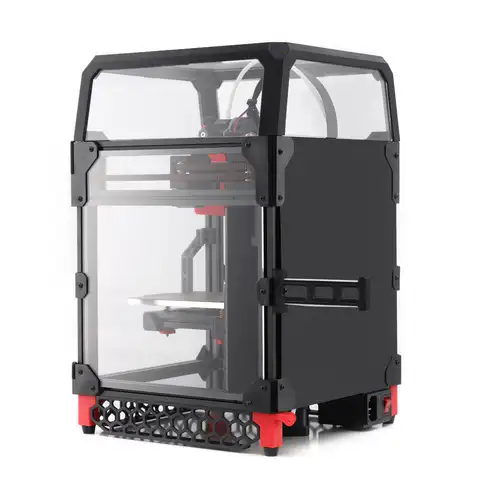 nine0003
nine0003
Although Ultimaker manufactures its own filaments, the S5 is open and can be used with any 2.85mm filament. It prints over WiFi as well as other methods and can be monitored remotely using the built-in camera.
When you purchase the S5 Pro Bundle, you get access to 24/7 automated material handling, air filtration and heat control for 6 filaments, as well as an Air Manager that further encloses the 3D printer.
Highlights:
Ultimaker s5 with optional pro kit including housing, air filter and filament storage
Buyer's Guide - what to look for
Fully or partially enclosed chamber
Partially enclosed chamber printers are a bit of an oddity because they don't provide ideal printing conditions with either of the two main filament types, ABS and PLA. However, they provide an extra layer of security, which is useful for educational institutions or those with children. We recommend a fully enclosed chamber if you plan to print with ABS, and an open chamber if you choose PLA as your media. If you are going to print with ABS and PLA, choose an enclosed printer with removable covers. nine0003
However, they provide an extra layer of security, which is useful for educational institutions or those with children. We recommend a fully enclosed chamber if you plan to print with ABS, and an open chamber if you choose PLA as your media. If you are going to print with ABS and PLA, choose an enclosed printer with removable covers. nine0003
Stock Volume
Build Volume is the printable area available to you on a closed printer. In other words, it is a measure of the size and type of prints you can make. If you are planning on making large prints or multiple copies, we recommend high volume printers such as the Ultimaker S5.
Material Compatibility
The enclosed 3D printer is designed to be compatible with a wider range of media types by being able to maintain higher temperatures around prints and keep cold air out. ABS is the most common type of material for sealed chambers, but you will also find printers that can work with nylon, PC, and other heat-sensitive materials. PLA can also be used if the printer covers are removable as this material requires cooler ambient temperatures for best results. nine0003
PLA can also be used if the printer covers are removable as this material requires cooler ambient temperatures for best results. nine0003
Heated bed
Given that the purpose of the closed chamber is to provide a stable thermal environment for printing with more complex materials such as ABS, a heated bed is a must. It helps provide an additional source of heat directly below the print, which promotes layer adhesion and slows down the cooling rate, thus avoiding unwanted defects such as warping and curling.
Connectivity
Connectivity defines how you interact with the printer, whether it's sending cut prints or fine-tuning settings. An SD card reader is more or less standard, as is USB in many cases, but for ease of use, there's nothing better than a Wi-Fi connection and thus cloud printing and monitoring.
Layer Resolution
Layer Resolution indicates the smallest layer height that can be printed. Choose a printer with a lower layer resolution for parts with more detail, such as 20 microns on the Ultimaker S5. On a closed FDM printer, 100 micron layer resolution is relatively standard and allows for a wide range of detail. nine0003
Choose a printer with a lower layer resolution for parts with more detail, such as 20 microns on the Ultimaker S5. On a closed FDM printer, 100 micron layer resolution is relatively standard and allows for a wide range of detail. nine0003
Filters
If you're buying a sealed chamber, your plan is most likely to include ABS printing. ABS not only has an unpleasant odor, but also emits potentially harmful fumes. A printer equipped with filters, carbon or HEPA, helps to extract the most toxic elements from the fumes. In addition, we also recommend working with ABS in a well-ventilated area.
Touch Screen
For convenience, we recommend an enclosed touch screen 3D printer. After all, we're all used to scrolling and swiping on our phones, so it makes sense to want the same functionality and familiar interface when working with a 3D printer. Most modern printers come with a touch screen as standard. nine0003
Price
Closed printers tend to increase in price as you pay for additional production and design. But thanks to the ever-increasing popularity of the budget category, enclosed camera printers are more affordable than ever before. You can easily buy a reliable indoor 3D printer for less than $400. Naturally, if you have the budget, new professional-grade printers that cost thousands of dollars also hit store shelves every year. nine0003
But thanks to the ever-increasing popularity of the budget category, enclosed camera printers are more affordable than ever before. You can easily buy a reliable indoor 3D printer for less than $400. Naturally, if you have the budget, new professional-grade printers that cost thousands of dollars also hit store shelves every year. nine0003
Benefits of Enclosed 3D Printers
Better ABS and Nylon 3D Printing
Housings can cool parts more slowly and maintain a more stable and higher temperature in the working chamber. This reduces buckling and splitting during the printing process.
Much safer
3D printer housings keep hot parts such as the nozzle and heated bed away from children if you have a family at home or if 3D printing is done in schools. nine0003
Quieter
The closed area keeps noise out, making them ideal quiet 3D printers. The enclosures keep out the buzz and hum of the printing process, which is a real boon if you're typing at home or in confined spaces with poor acoustics that can amplify noise levels.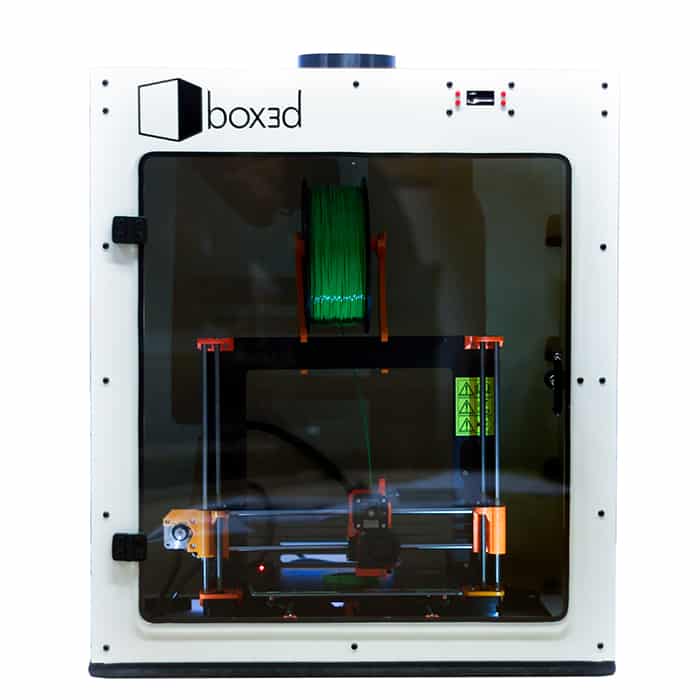
Stronger and More Reliable
Enclosed 3D printers typically feature a sturdy four-walled cubic design that keeps vibrations and other factors from degrading print quality. nine0003
Noise Reduction
Enclosures help reduce noise by reducing hum and hum during printing, which is a real boon if you're printing at home or in confined spaces with poor acoustics that can amplify noise levels.
Drawbacks of Enclosed 3D Printers
More Expensive - 3D printers with enclosures are more expensive than open FDM printers. The logic here is obvious: manufacturers are forced to spend more money on raw materials and the assembly process, which invariably reflects on consumers. nine0003
Difficulty in maintenance and troubleshooting - Due to the closed design, maintenance of an enclosed 3D printer is much more difficult. Cleaning, replacing, troubleshooting or upgrading parts is much more of a hassle than an open design 3D printer.
FAQ
What is the 3D printer case for?
Enclosures help improve print performance by keeping hot air in and cold air/draughts out. For heat sensitive materials such as ABS, a stable higher temperature environment is critical for proper layer adhesion and reduced chance of warping, curling and other problems. Likewise, the shroud helps prevent dust and dirt from getting on printer parts and the print itself; this is essential for successful printing as contamination can affect adhesion and print quality. nine0003
Are closed 3D printers safer? Why?
Yes. The housing shields hot and moving parts from prying fingers and hands, reducing the chance of injury compared to open design printers where all parts are exposed and easily accessible. Whether you live with children or work in an educational setting with younger students, an enclosed 3D printer will give you peace of mind. In addition, filters, often installed in enclosed printers, remove toxic elements from the fumes.